Archives 2023
Judit Ungvári: Harmony of Diversity and Unity
The Madách International Theatre Meeting, held in the framework of the 10th International Theatre Olympics, once again provided many exciting lessons. It raised three major themes: the war, humankind’s ecological responsibility and the dialogue between East and West in the language of theatre – and sometimes these themes overlapped.
The ancient Olympics were a time of peace and dialogue, and the Theatre Olympics was conceived along similar lines, as we heard during a discussion of theatre-historic significance[*] between two founders of the Olympics and emblematic creators of world theatre, Tadashi Suzuki from Japan and Theodoros Terzopoulos from Greece. The 83-year-old Japanese master reflected on whether humanity has become more advanced thanks to the modernisation of technology. According to Suzuki, advanced civilisation vs human advancement is one of the most important issues today and also chimes in with the ecological theme of the meeting. Terzopoulos discussed the issue of weapons vs muses in the context of the birth of the Olympic ideal, and expressed his conviction that there is no future without traditions rooted in nationally culture. In this context, he highlighted the importance of particularities vs globalisation and the dialogue between East and West.
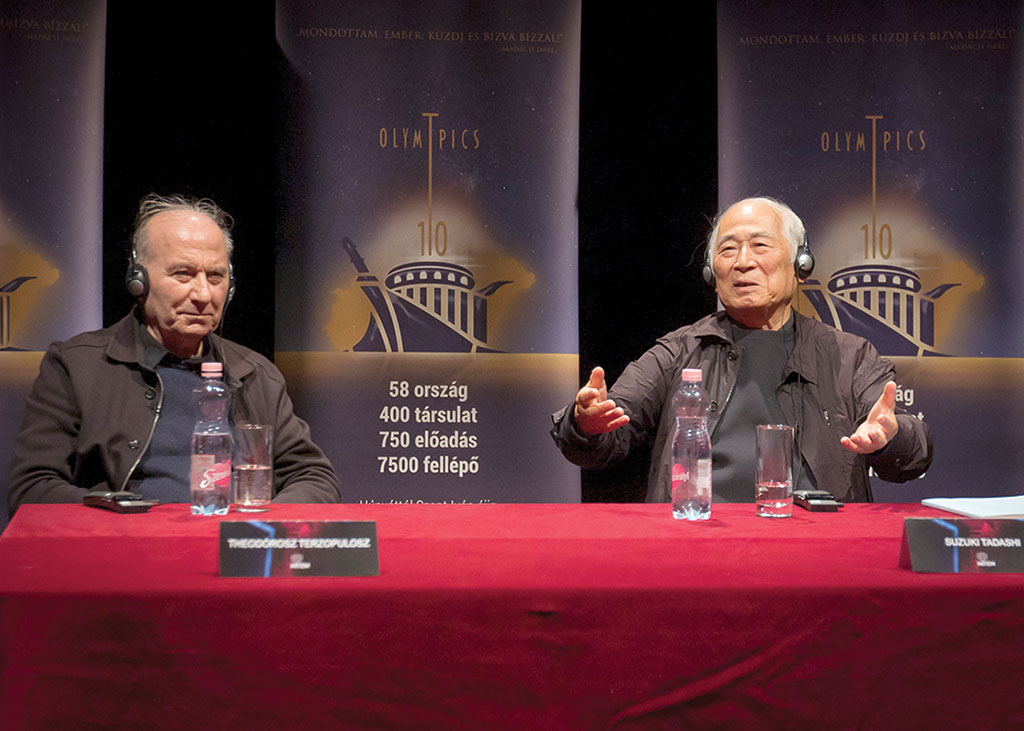
Advanced civilisation vs human advancement
Can we change at all? Can we keep pace with the explosive technological advances? Or are we mostly running round the same circles, as we have so many times since the dawn of civilisation? According to Tadashi Suzuki, Greek plays contain all the fundamental conflicts that still characterise human coexistence: crime, war, family conflicts.
Illusions about human nature
Liberty Theatre from Tbilisi adapted two well-known Shakespeare plays, Othello and Richard III, exploring the eternal problem of human evil and reflecting on our times, too. The style of director Avtandil Varsimasvili may not be unfamiliar to Hungarian spectators, since in January, he directed the National Theatre’s production of Brecht’s The Caucasian Chalk Circle. Now we had a first-hand experience of his own workshop at home: his Georgian theatre employs a theatrical, powerful, spectacular acting style with high emotional amplitude.

Both productions featured innovative, brilliant theatrical solutions, such as the multifunctional stage ’object’ of Richard III: this steel structure could be transformed as need be into a table, then into a cell, but it could also function as a coffin and, in some cases, as a bridge plank. In Othello, the crossbar with the curtains proved to be a similarly versatile object: it could be interpreted as an entrance to a bedroom, as a sail hoisted on a bar or as a stage.
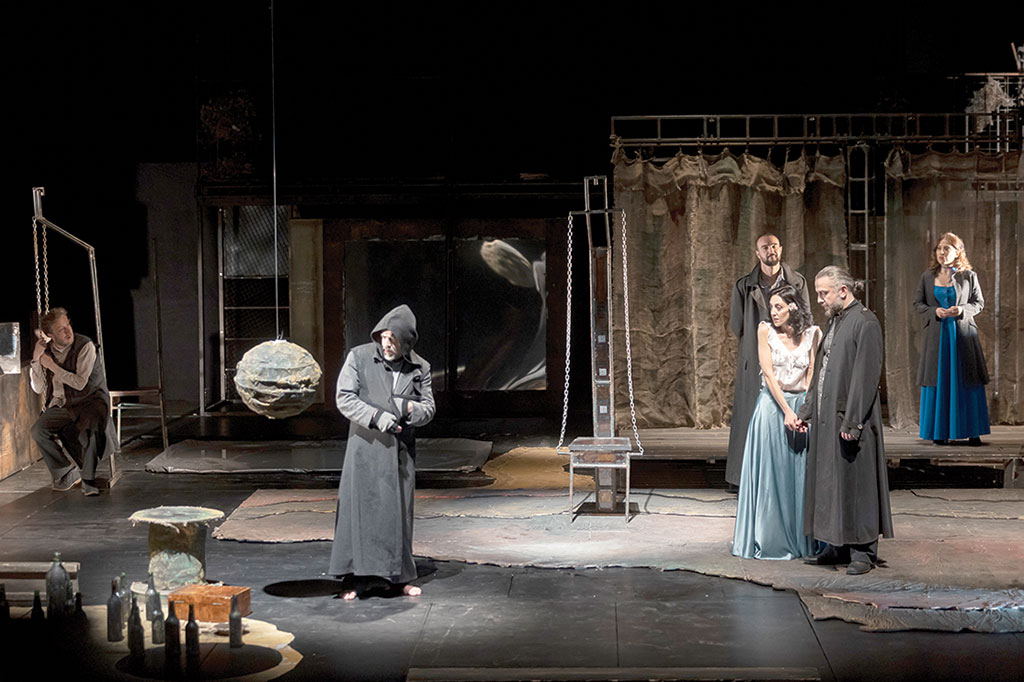
The director’s concept of Richard III (Apolon Kublashvili) resembling a devil with hooves (in the limelight at one point) was impressive and thought-provoking. As was the climax in Othello, when the title character (Goga Barbakadze), instead of simply strangling Desdemona, memorably played by Ani Alidashvili, wraps her in a blood-red shroud as though in a ritual sacrifice.
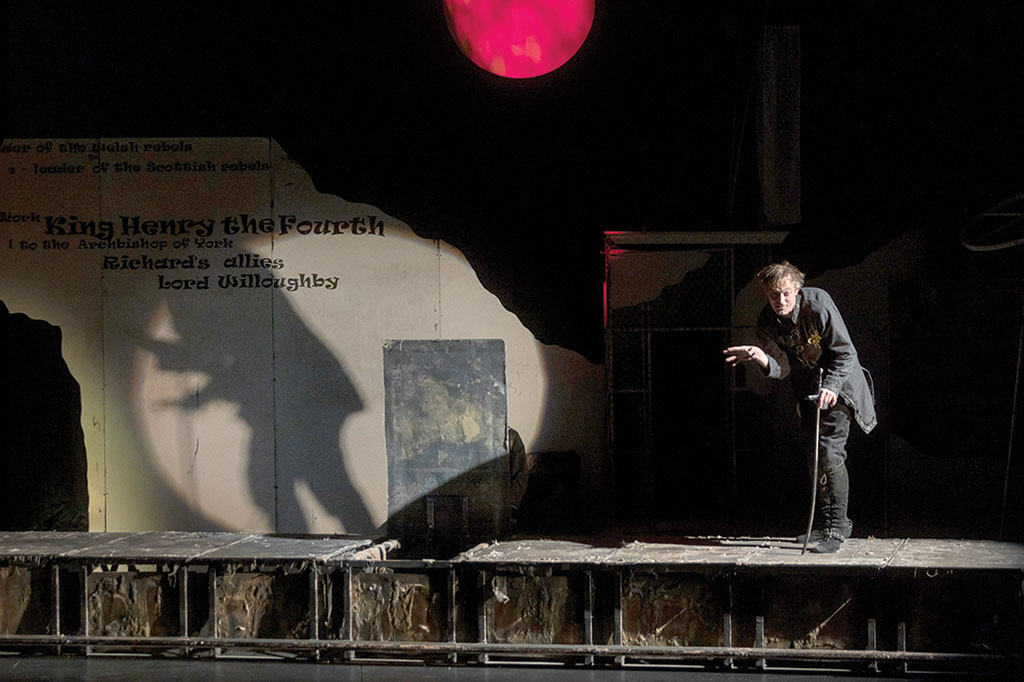
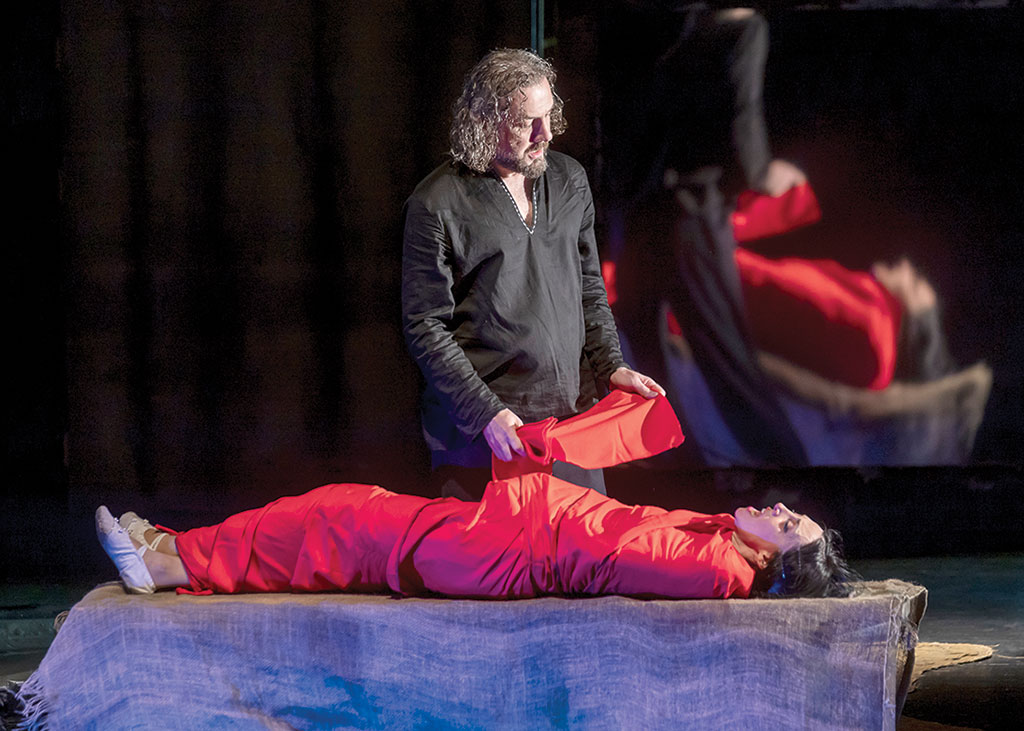
Murder, violence, revenge in Shakespeare’s plays, as in Greek tragedies, are man’s ‘scourge’, a pathological condition from which he should be cured. The Suzuki Company’s Electra is a case in point: by setting the action – or rather its aftermath – in a psychiatric ward, this adaptation hands down a severe verdict on the mental state of Clytemnestra for murdering her husband, and on their daughter Electra for seeking revenge. Avtandil Varsimashvili’s Richard also demonstrates that the crimes of a man wading through dead bodies are intrinsically punished as we watch him gradually descend into madness with fear and distrust. Distrust is also an apt keyword to describe Othello’s mental state: in his case (as the director put it at the meeting with the audience) we witness his struggle with his complexes as he succumbs to evil machinations without resistance.
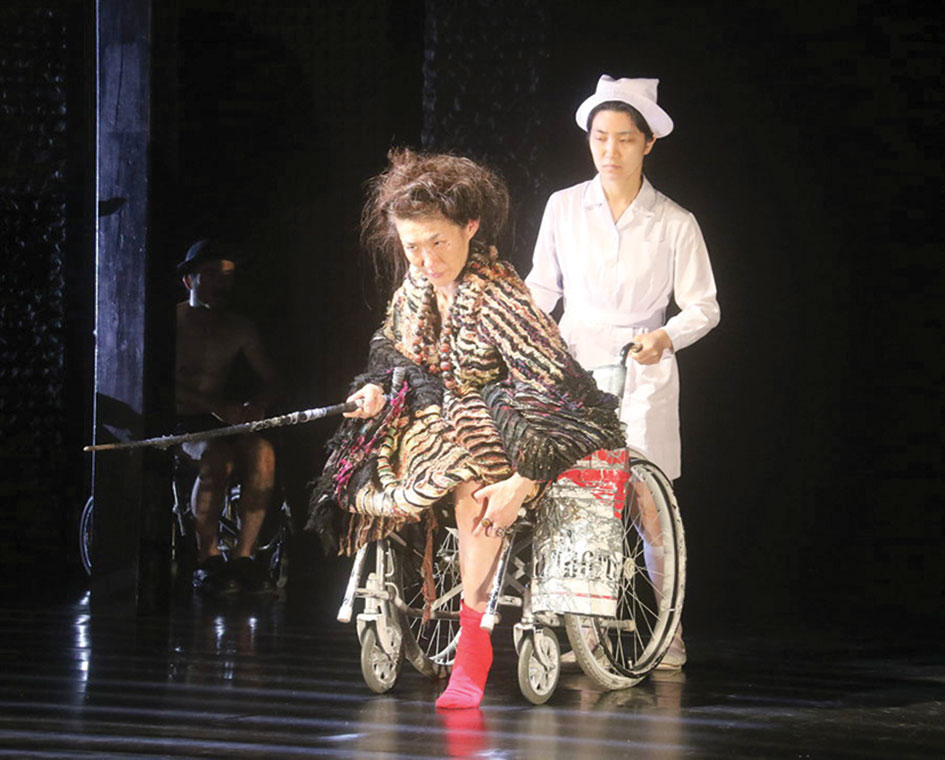
Clytaimnestra and her nurse (source: mitem.hu)
Director Declan Donnellan explored the cruel interplay between the imaginary and reality in his adaptation of the great Spanish Baroque author Calderón’s Life is a Dream. This was the first Spanish-language production of Cheek by Jowl, a London-based international company founded in 1981.
‘…What intrigues us in Calderón’s story is what has always been part of the human condition: virtual reality has been with us since the dawn of time. Thanks to our imagination, we have always found a passageway to another form of existence. Interestingly, genuine art can always take us back to reality. Human nature does not change, only technology does. Of course, the latter can open up frightening perspectives,’ – said the director in an interview.

The director, who is ‘Irish by birth, English by upbringing, European by culture’, received a huge ovation in Madrid last December for this production, and critics lavished praise on him. His was an exciting undertaking in every sense, as it must have been a daunting task to trim the sprawling, intricate Spanish classic full of twists to a palatable size for modern audiences. Another challenge was the issue of modernity: it would have been a waste to stage such a play as a period piece out of a museum. Donnellan and his permanent partner Nick Ormerod created a thoroughly modern production with minimalist sets and costumes that are indicative only, but distinctly contemporary. On the other hand, they did not modernise the text at all, preserving the original language of the Spanish classic. The contrast between the archaic text and the production’s contemporary appearance is one of its greatest achievements. The audience is addressed directly all the time, creating an atmosphere of intimacy and closeness. The sitcom-style of the performance was interesting, as it responded to today’s issues and reflected the world of TV shows. Of the Spanish cast, the performances of David Luque, Ernesto Arias, Manuel Moya and Irene Serrano were particularly noteworthy.
The other London-based theatre, Complicité, turning 40 this year, also brought a new production of its own, ‘Drive your Plough Over the Bones of the Dead’, based on the work of Nobel laureate Polish writer Olga Tokarczuk. This multi-genre stage adaptation is in a league of its own: is it an eco-novel, a metaphysical crime story or, as The Guardian put it, ‘an existential thriller’? The production, based on Simon McBurney’s philosophical novel embedded in a detective story, is very recent: it premiered in December 2022 and has received accolades in the international media for its innovative directorial concept, masterly technical execution, the quality of its physical stage solutions, and the humour with which the creators present the serious, topical social and political message. In broad terms, one can agree with all that, though one could argue that the production is overly text-centred: the protagonist’s narrative dominates the stage almost throughout, just about turning the play into a monodrama. However, the stage design, choreography, video installations and special lighting effects (stage and costume design by Rae Smith; lighting design by Paule Constable; sound design by Christopher Shutt; video design by Dick Straker; movement by Toby Sedgwick) make up for that. The lead actress, Kathryn Hunter, despite her frail frame, carries the performance with enormous energy, authentically communicating the writer’s underlying sense of ecological responsibility, i.e. that we humans have a duty to animals: we must help them live out their lives and must return our pets’ love and affection, because they give us so much more than they receive. Hunter is a great actress: she has won the Laurence Olivier Award, played male roles, such as King Lear and Richard III, and has also directed at the Royal Shakespeare Company.
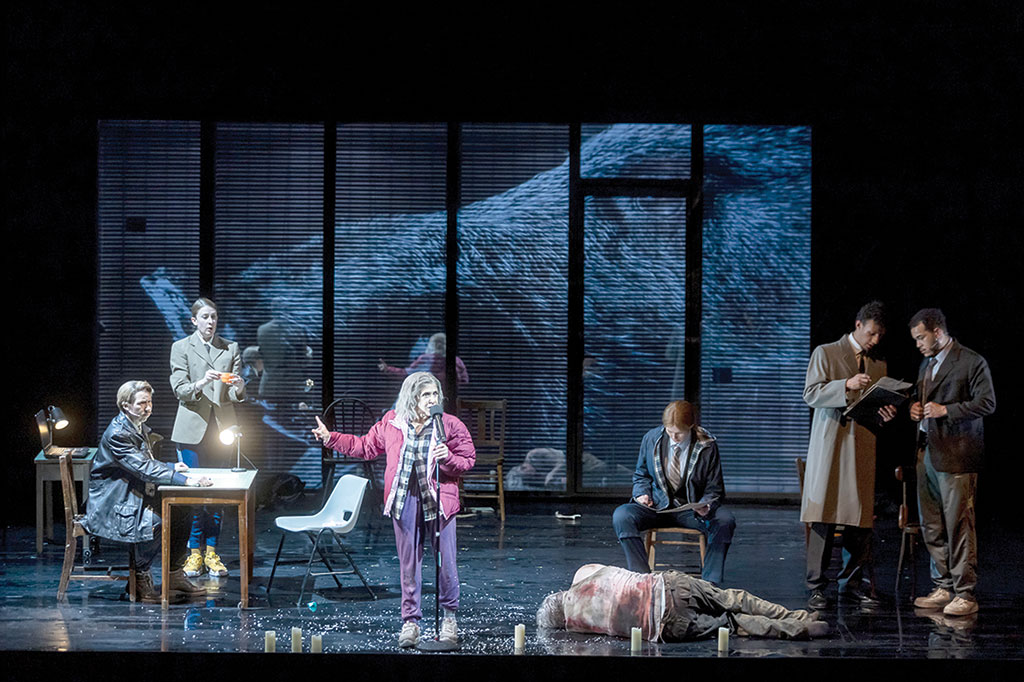
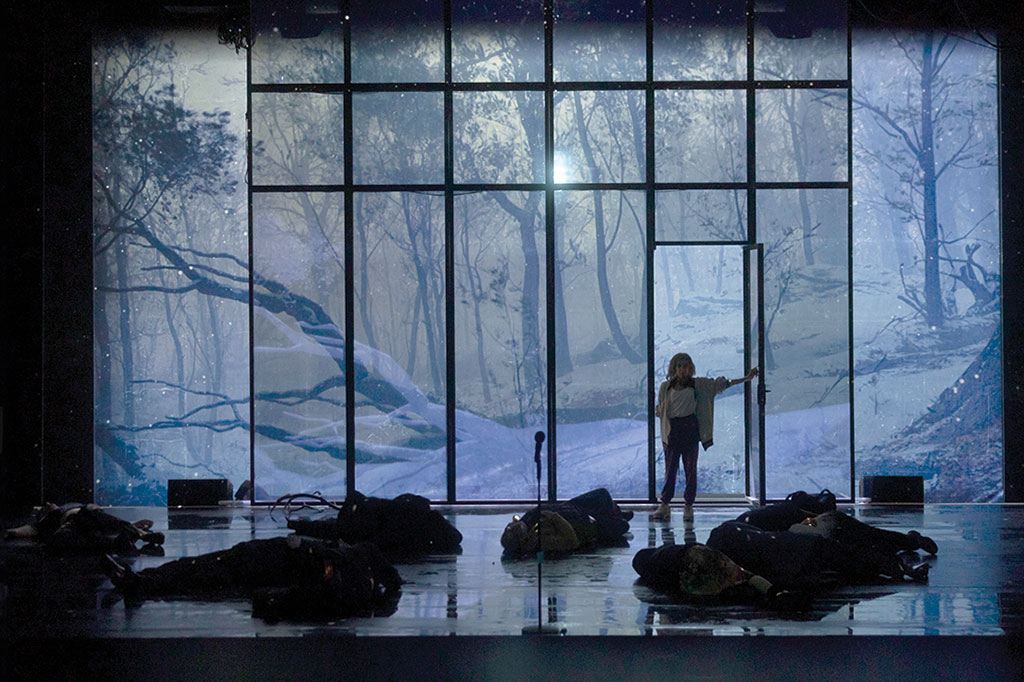
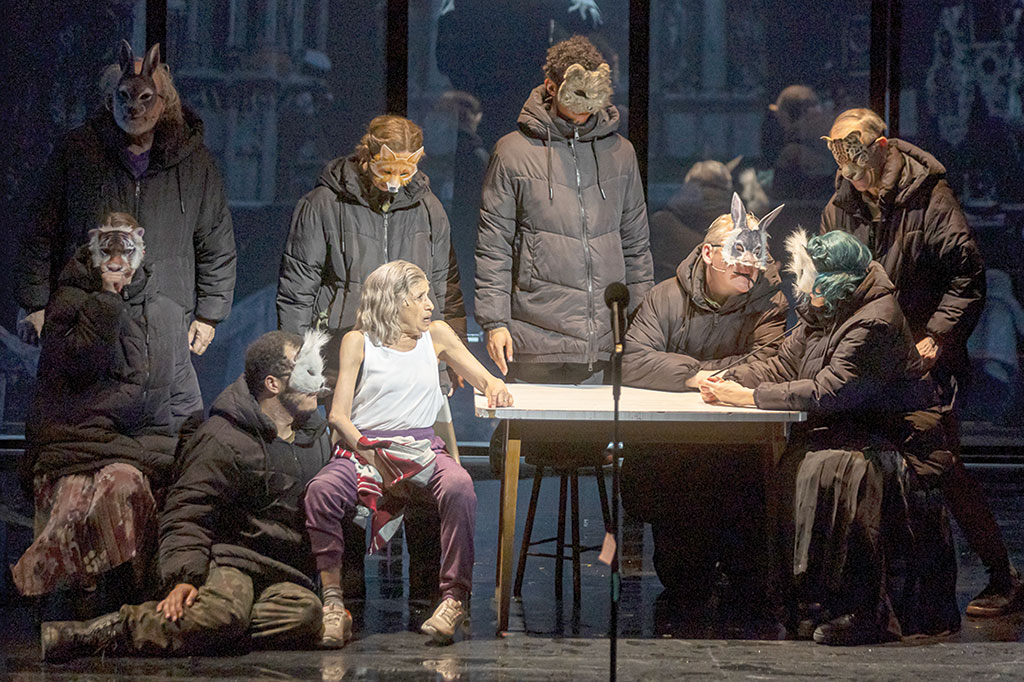
The second piece of the festival’s eco-theme was directed by world-famous Belgian ‘interdisciplinary artist’ Jan Fabre. Writer, director, choreographer, performer, painter and sculptor, Jan Fabre composed his production of Resurrexit Cassandra to the poetic lyrics by Italy’s Ruggero Cappuccio, written especially for this performance. The poetic text was brought to life as a dance drama in this one-woman show, and German actress Stella Höttler gave a stunning, ecstatic metamorphosis performance.
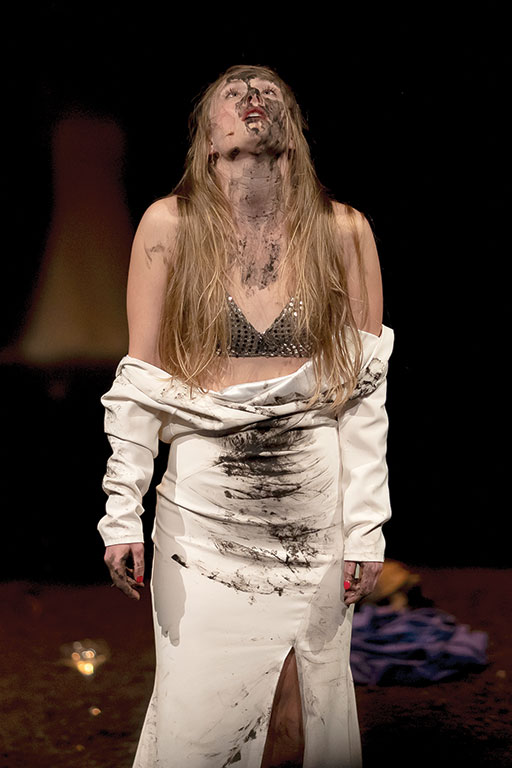
Antwerpen, 2019, d: Jan Fabre, in the photo: Stella Höttler
Cassandra’s ‘resurrection’ draws attention to our ‘universal human hubris’: we believe we are not inferior to the gods and treat everything on Earth extremely wastefully, to the point of depriving ourselves of the bare necessities of life so we become the victims of our wastefulness. It is not by accident that Earth appears in the performance, not only as a reference, but also as a concrete material. The five colours – the lush green of Eden, black for fertile soil, royal blue for the sea, blood red and finally white, representing the airiness, coldness and emptiness of space – were also present physically, as they followed each other in this sequence whenever the actress changed her clothes, giving the play and the interpretation a particular trajectory. The appearance of the turtles was also exciting. The symbolism of this hard-shelled prehistoric animal is incredibly rich: in Asian cultures it played a major role in the creation of the world, in Western cultures it symbolises wisdom and longevity. Darwin arrived at the idea of evolution based on the Galapagos tortoise; and from this perspective the troubling question arises: does man, at the ‘pinnacle’ of evolution, deserve the gift of Earth? How many times must Cassandra be resurrected before we listen to her and heed her prophecies?
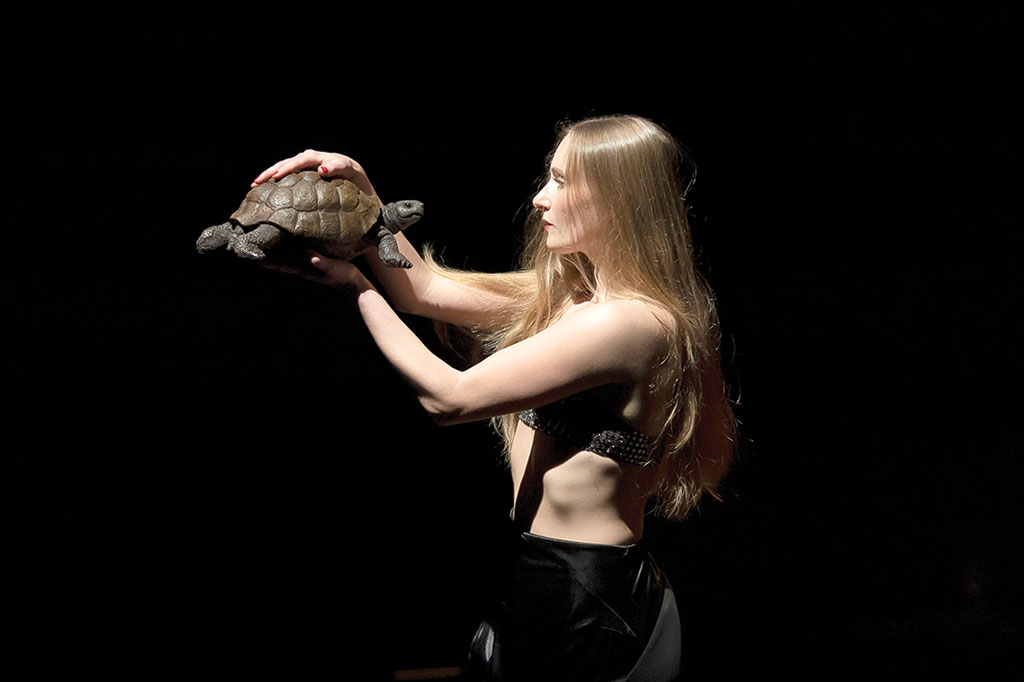
Our responsibility to nature and the animal kingdom was also present in the Kafka adaptation A Report to the Academy. Founded in 2008, the young Greek company Zero Point Theatre of Athens adapted under the direction of founder Savvas Stroumpos one of Franz Kafka’s well-known metamorphosis stories about the humanisation of a monkey called Rotpeter.
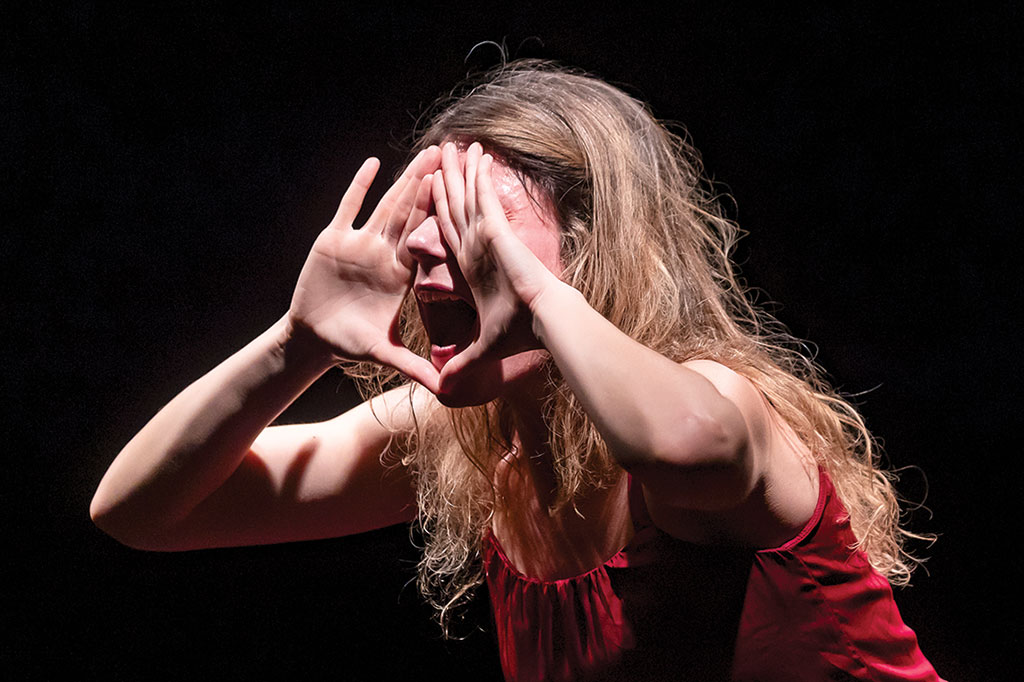
The same dichotomy, animal vs human, was presented with plenty of humour in the brilliantly absurd sketch comedy CCY-Witkac-y-Menagerie by Witkacy Theatre of Zakopane, based on the juvenalia of Polish avant-garde theatre genius Stanisław Ignacy Witkiewicz. The creators contrast the playful childhood impersonation of animals with the final scene’s dystopian phalanster vision of people in grey clothes groping about blindly, which director Andrzej Stanisław Dziuk intended as a very concrete reference to today’s disoriented society blinded by fear, prosperity, laziness, and the media.
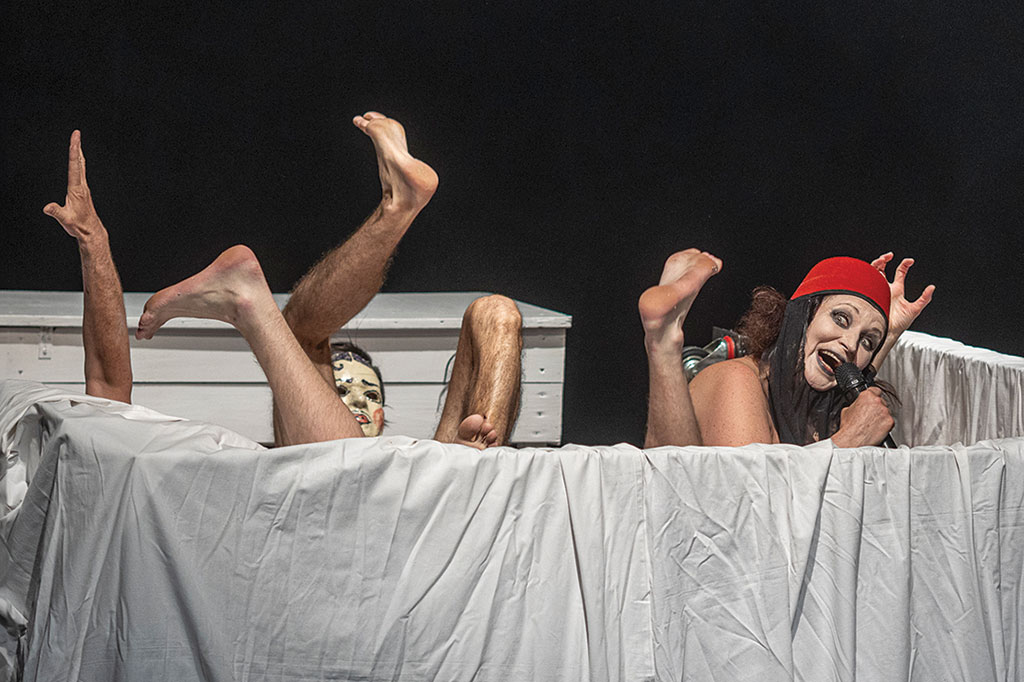
Guns vs muses
War was the other focal theme of this festival, although one wonders in several cases whether the artists were reflecting on an ongoing conflict or on their premonition of the threat of war. The latter may be true in most, which demonstrates the power of art and justifies the juxtaposition of the two terms in the heading. For in times of war, the muses may not be silent at all – many productions revealed brutal and depressing current scenes along with stage poetry that survives it all.
A war of narratives – this is the shocking diagnosis established in Robert Icke’s The Doctor, premièred in London in 2019, staged by the company of the Csiky Gergely Hungarian State Theatre of Timisoara, directed by Romania’s world-famous Andrei Șerban. The production is an ironic reflection on current phenomena around racial, religious and sexual identity, criticising prejudices as much as it criticises the opposing woke culture.
The Doctor is based on Arthur Schnitzler’s 1912 play Professor Bernhardi, skilfully updated by the contemporary author. The basic conflict is that Ruth Wolff, founding doctor-director of the Elizabeth Institute, refuses to let a Catholic priest into the operating theatre where a girl is dying because of a self-administered abortion. This turns into a media scandal that leads to professional harassment that practically ruins the protagonist’s life and career. But while Schnitzler’s play includes a real court hearing, Icke’s adaptation focuses on media bullying. In this environment, one camp’s leading opinion often becomes definitive. The ‘public’ passes judgement on professional competence and even the person without knowing the facts. Without responsibility and without consequences.
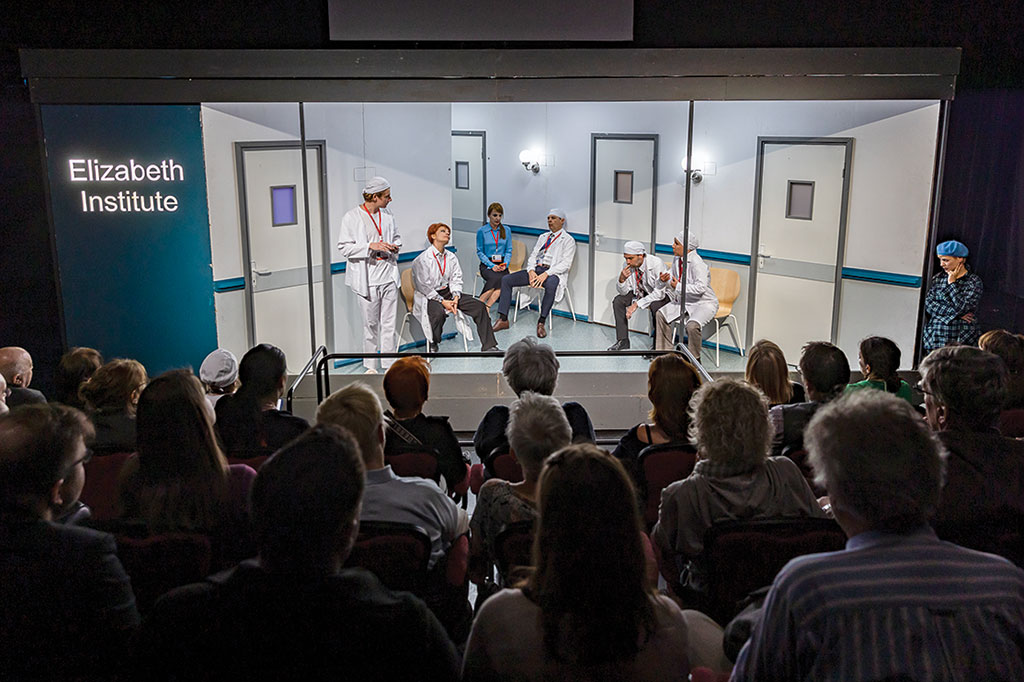
Romanian director Andrei Șerban knows how to play with styles even in this very realistic piece: after sitcom-style acting and scenes, he almost imperceptibly shifts into hard-core drama harking back to classical tragedies. The actors deliver meticulously developed characters with clear motivations and voices. The hardest task is undoubtedly that of the leading actress: in the version I saw, Erzsébet B. Fülöp was thoroughly moving in the role of Ruth Wolff.
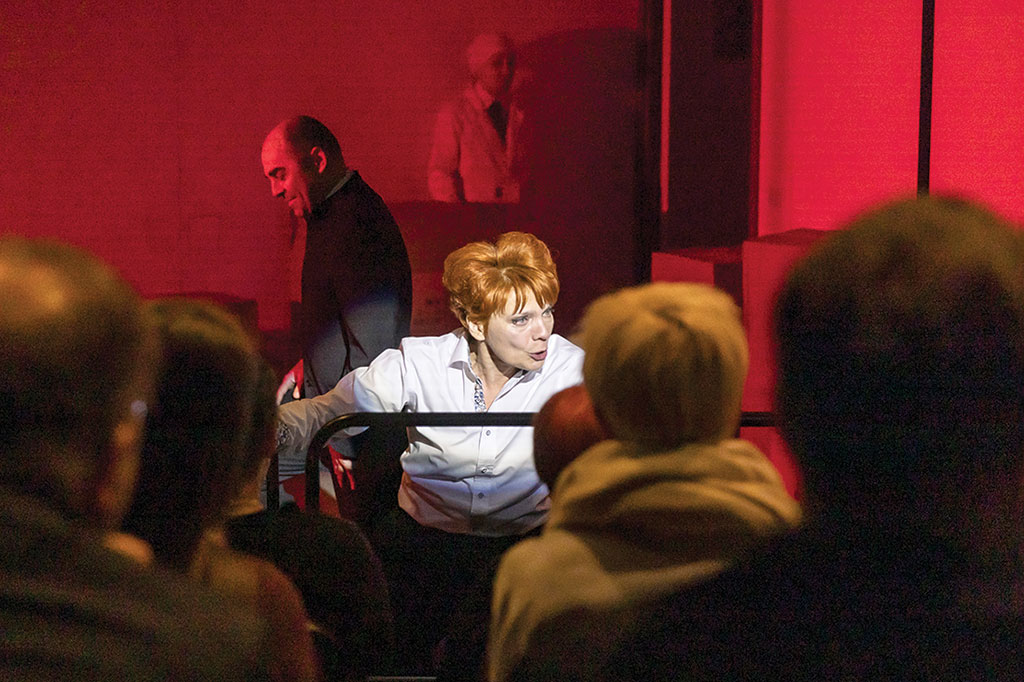
Bros by Romeo Castellucci and the Societas company of Cesena was premièred in October 2021 at FIT Festival, Lugano, South Switzerland. The director made it clear in advance that he would be working with a locally selected cast receiving their instructions through earpieces. This may be interpreted as a metaphor for real-life co-operation: do we know where we are guided and what we are instructed to do, by whom, with what intentions? Do we still have our own free will? Spectators are left to ponder many unsettling questions in the course of this alarming vision. An old Romanian actor, Valer Dellakeza, appeared at the beginning of the performance, chanting from the Book of Jeremiah in his mother tongue, indistinctly. He is the misunderstood prophet who used to warn the people of Israel of the threat of slavery, he starts and ends the performance, as the young boy who appears at the end is presumably his reincarnation.
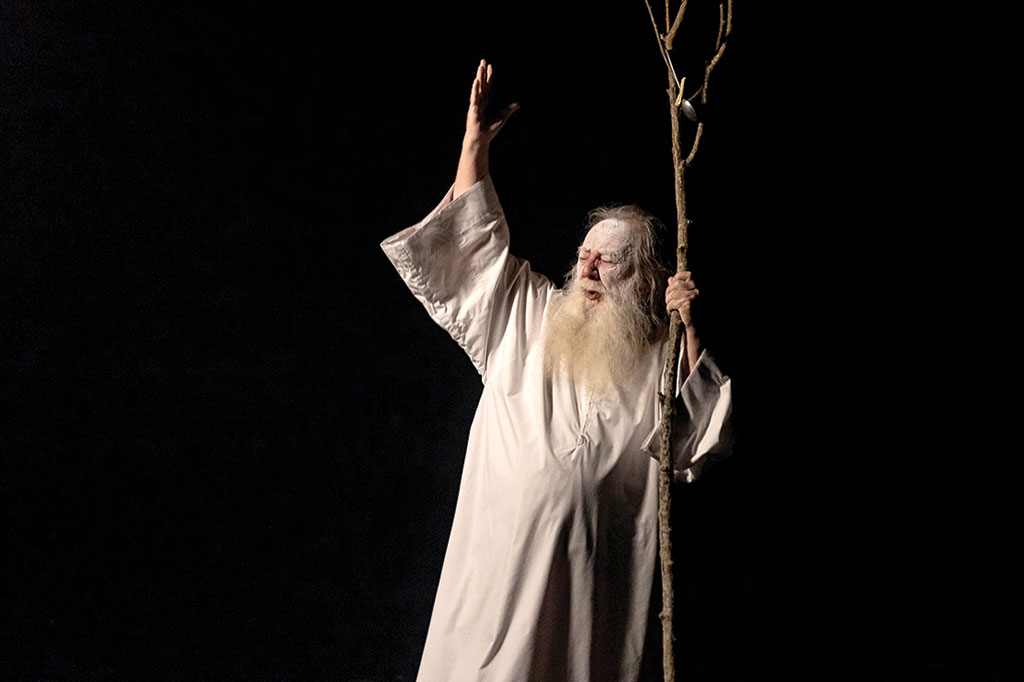
The director’s collaborator Silvano Voltolina told the audience meeting that Castellucci’s first inspiration for this production came as he saw the police swarm the streets of Paris after the terrorist attacks. Most people in the Budapest audience were frustrated by the march of policemen with dogs into the auditorium and forming a terrifying line. It was also chilling to see people twitch like fish out of water or to watch them beat and torture each other. Because the essence of the police metaphor is that any one of us can be an executioner or a victim. ‘Hell itself, although eternal, dates from the revolt of Lucifer,’ says Beckett in a recording shown during the performance. But we may also quote Sartre: ‘Hell is the others’ (l’enfer, c’est les autres). And it may well be that hell is within us, and that they that punish others punish themselves. We don’t yet know whether the boy in white receiving the baton at the end of the performance and striking his palm with it will choose to be a prophet or a policeman. “Pullo et Ovo,” reads the inscription on the black curtain. A good question, indeed, which came first: the chicken or the egg…
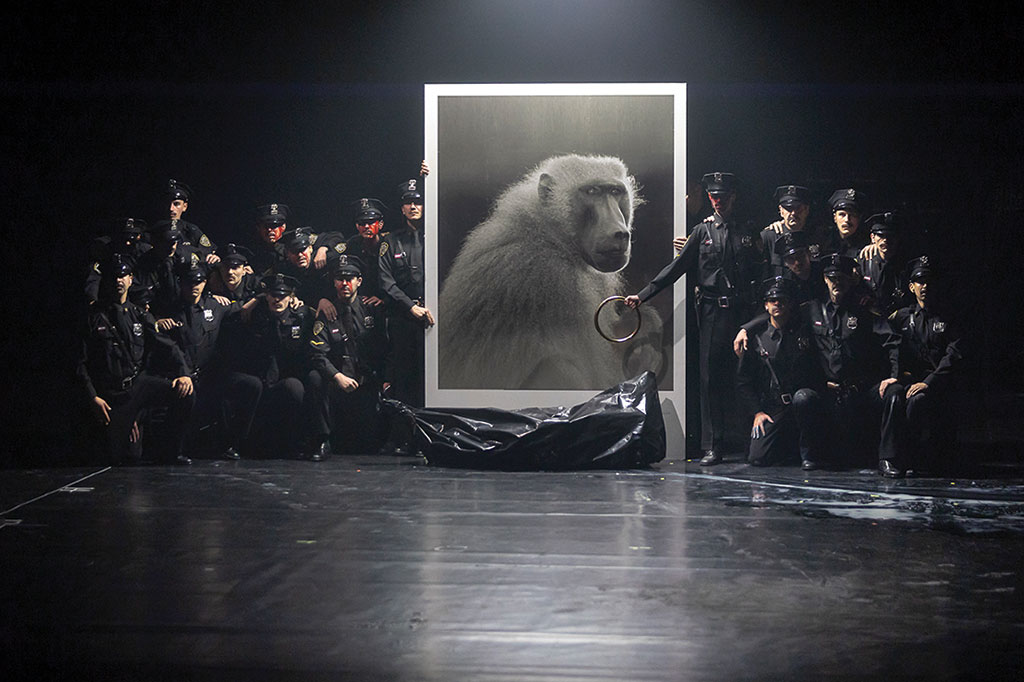
Euripides’ classic The Trojan Women is brought to MITEM by Wybrzeże Theatre from Gdańsk, directed by Jan Klata. Dramaturge Olga Śmiechowicz combined three plays in this adaptation: Euripides’ The Trojan Women and Hecabe, and one of his satires on a related theme, which was removed from the production when the war in Ukraine broke out.
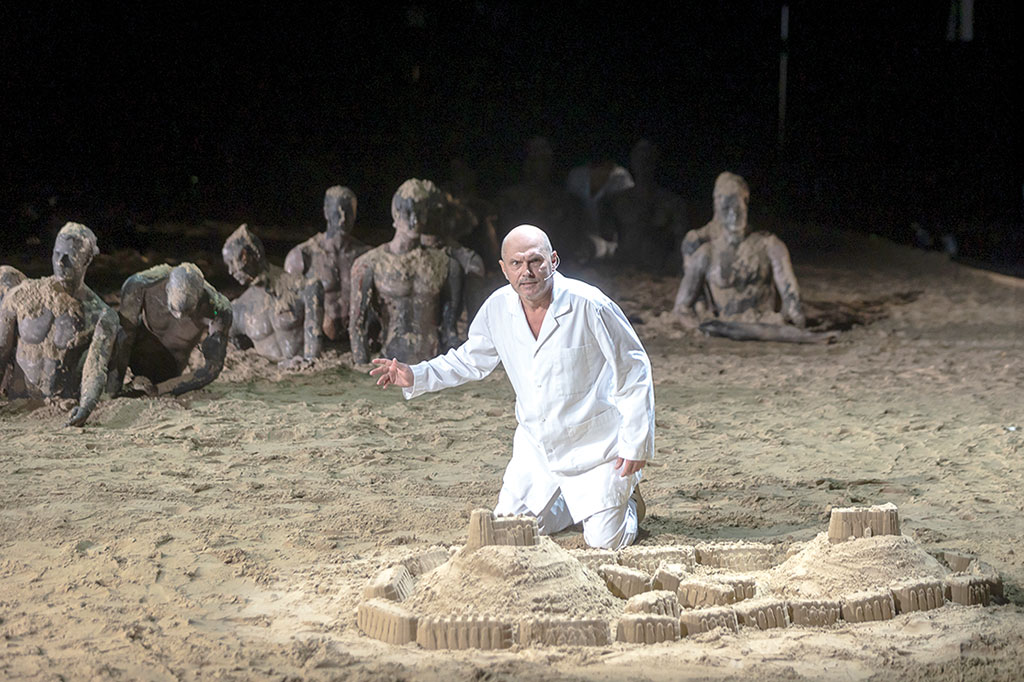
The opening scene is memorable: a sandcastle against the backdrop of a sea of sand covering the stage; a punk girl standing behind it wearing something like a wedding dress, boots, and holding an electric guitar – enough to tip the audience off that she may be Cassandra. Then enter the gods and kick the sandcastle apart like little kids in a playground. Cassandra strikes the strings and we learn what happened in Troy the day after the Greeks won.
Jan Klata’s direction nails the spectators to the seat and won’t let go of them for one moment. The stage visuals are stunning (set and costume design by Mirek Kaczmarek). The actors stumble among the torsos of male statues sunk in the sand, and the costumes are astonishing: the chorus of women wears a single black hooded top made for several heads; or the haggard appearance of the Greek warriors with the stiff dumb antique faces on their masks and six-pack T-shirts under their clothes. The first climax of this superbly composed performance is Polyxena’s ‘sacrifice’. This scene of rape and murder is both beastly and poetic – it is an exceptional achievement by the company to have managed to present both qualities at the same time.
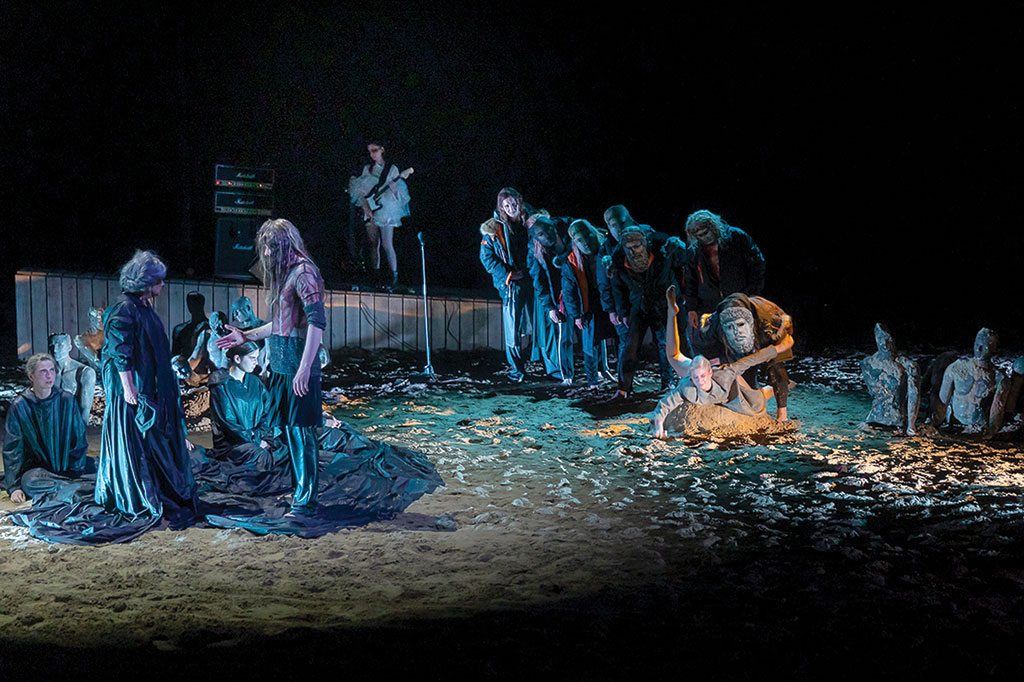
‘History is written by the victors,’ cited the creators the well-known proverb at the audience meeting. But this performance also poses very specific questions, such as: would we, like the ‘civilised’ Greeks, be as barbaric as the ‘barbarians’ we defeated? Would we take revenge for the killing of our loved ones the same way as Hecabe? Can a theatre performance change man’s thirst for revenge? The question is obviously rhetorical.
The National Theatre of Belgrade presented a cathartic and beautiful adaptation of Tolstoy’s gigantic War and Peace. Dramaturge Fedor Šili condensed Tolstoy’s vast ocean of a text into a concise stage version (370 pages in first reading ultimately trimmed down to 70 pages). The outcome was a production that was both ‘palatable’ and true to the novel. Director Boris Liješević retained the main plot line and the narrative philosophy, but ‘abandoned’ the tableau. All the stage solutions merged into a vibrant, emotionally moving and thought-provoking whole. The emotional encounter of Andrei Bolkonsky and Natasha Rostova at the ball was as heartbreaking as Pierre Bezukhov’s plea to the audience, ‘raise your hand if you believe there will ever be peace’. Beautifully choreographed movement theatre (by Mirko Knežević) played a major role in this staging. The ‘dance’ of Andrei and Napoleon, for example, is very effective, evoking the battle of Austerlitz more expressively than any crowd scene. Danilo Lončarević as Andrei is exactly as one imagines the character reading the book: restrained and disciplined, yet full of passion. Teodora Dragićević portrays Natasha with extraordinary dramatic power. Hadži Nenad Maričić, who plays Pierre, creates a quirky, idealistic, heartfelt figure. Even in the smallest roles, we see profoundly understood and experienced characters; a few examples: Miodrag Krivokapić as Bolkonsky the elder or Nina Nešković as Sonja. The Belgrade National Theatre has an enviable company.

A grand theatrical tableau of history by Heiner Goebbels, one of the most important contemporary representatives of avant-garde theatre, Everything that Happened and Would Happen is a unique interdisciplinary artistic vision using Patrik Ouředník’s novel Europeana – A Short History of the Twentieth Century as a starting point, but also based on John Cage’s Europera 1&2 and no-comment news footage. The world première of the show combining live music, movement and large-scale multimedia installations was in 2018 at Mayfield Depot by Manchester’s Piccadilly station, and Budapest’s Tüskecsarnok provided a perfect setting for this poetic vision.
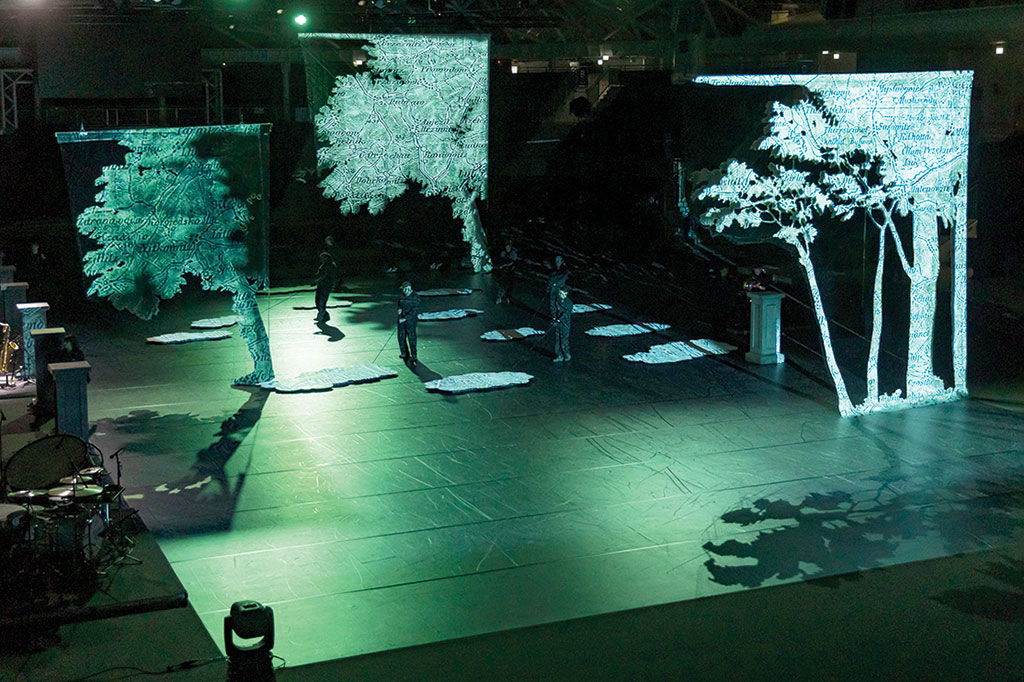
The performers in black coveralls kept moving in the rectangular space marked out by the musicians’ ‘sound stations’, pushing, pulling, dragging various objects and folding fabrics, some of which they would occasionally latch onto the descending supports. These were used both as projection screens and as visual elements with a meaning of their own. The rolling bins with neon tubes around their mouths resembling mine trolleys also served as practical storage containers for the various objects used in the performance. The music, largely based on noise art elements, dominated the entire production. The fragmented text used in the performance (the book is now available also in Hungarian) was presented with a subtle sense of humour. The Paris-based Czech author’s text resonated poetically with the imagery of today’s ‘media reality’ and John Cage’s experimental acoustic collage. The final scene’s long, tubular rods moving slowly to transform into tank barrels and the monstrous machine smoking ominously against the idyllic backdrop were a warning that it is not over; that Europe is still where it was a century ago, in the time of the Great War…
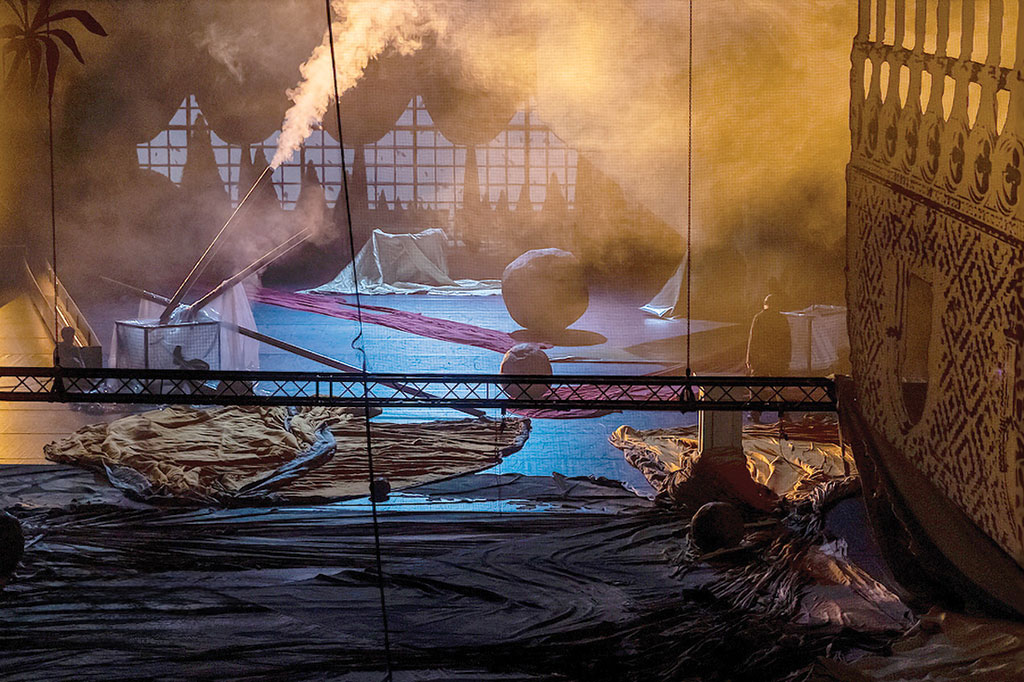
Produced by Teatro Stabile di Torino and Teatro Nazionale Torino, The Tempest is Italian director Alessandro Serra’s poetic vision of Shakespeare’s last play. The opening scene immediately captivated the audience: a huge, black silk billowing over the stage, with Ariel beneath it, moving the waves at the bottom of the sea. This grand vision was surrounded by the chaotic sounds of boat crews tossed about by a storm on unseen waters.
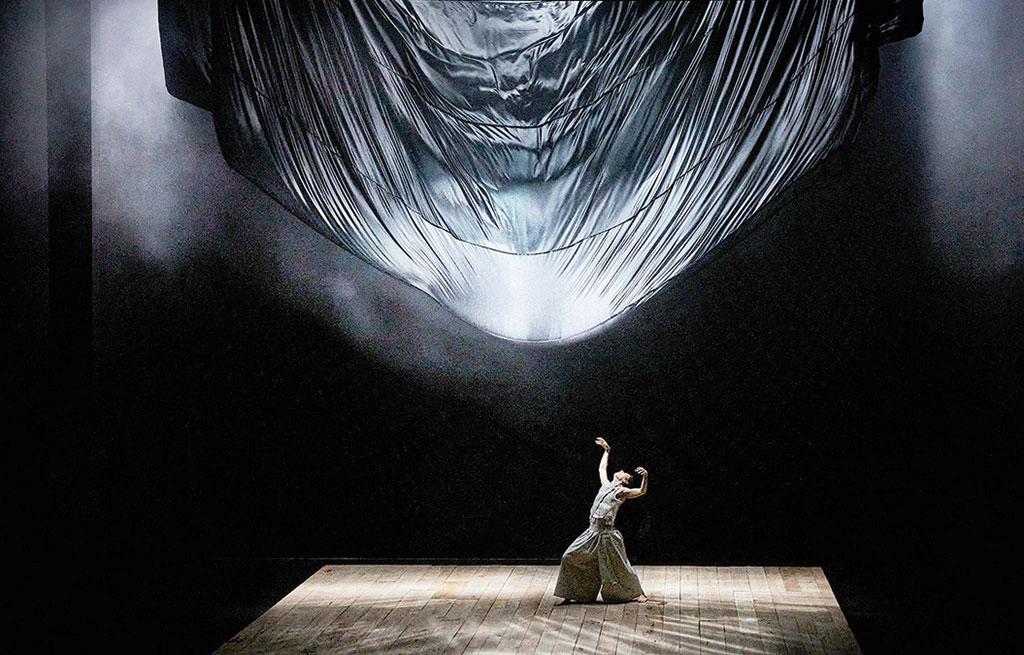
(photo: Christophe Raynaud de Lage, source: festival-avignon.com)
The minimalistic imagery of Serra’s Macbettu, a great success at last year’s MITEM, also characterised this production: the play of light and shadow, the white costumes against a black background, the contrast between the abstract empty space and garish clothes capture the audience’s attention from scene to scene. There are no sets, the space is organised by a single element: a square platform that acts as a stage on the stage. Serra, as he pointed out at the audience meeting, is creating real poor theatre, albeit relying heavily on improvisation. For him, the actor is the most important thing. It is not the written word that matters, but the encounter of living thought with the audience through the actor, in keeping with his master Yves Lebreton’s philosophy.
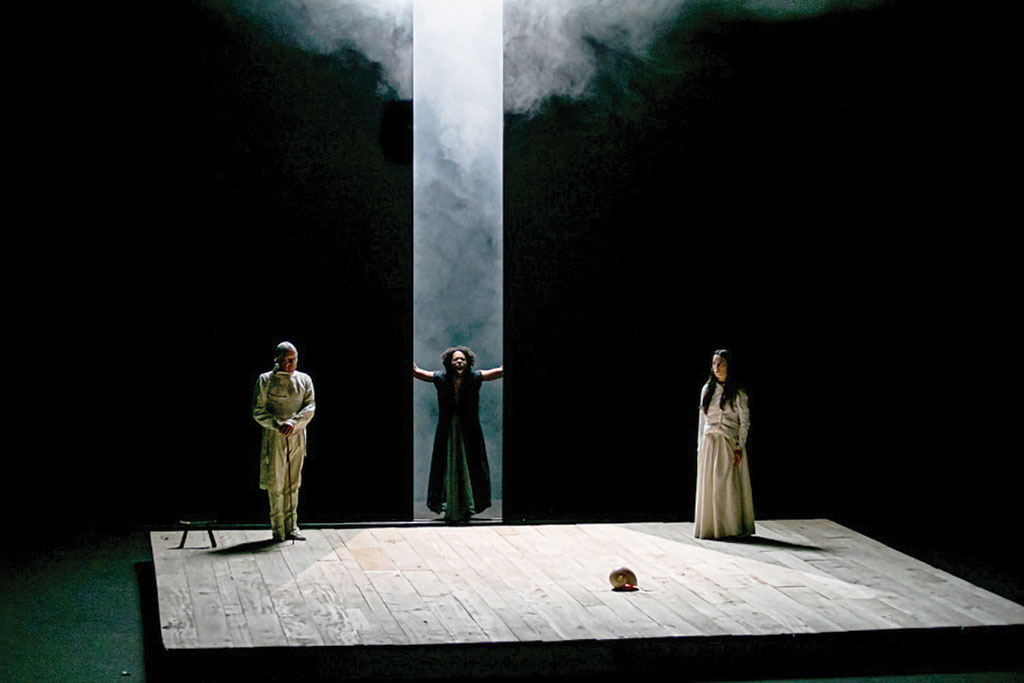
(photo: Stéphane Baré, source: ouvertauxpublics.fr)
The Tempest is about forgiveness and Prospero finds the strength to make this sacrifice. ‘Theatre is like life, it just won’t die’, said Alessandro Serra at the audience meeting.
An adaptation of Nikolai Erdman’s The Suicide was performed by the Théâtre National Populaire, directed by Jean Bellorini. The subtitle’s genre designation as Soviet vaudeville proved to be apt: indeed, it is a musical farce, but the performance was also a dazzling stylistic feat. A couple of years ago, the Macedonian National Theatre presented a much more realistic production at MITEM than the one we saw now. The current version, turning from a farce into a tragedy, tricked the audience into laughing through the performance thinking they were watching a pure comedy.
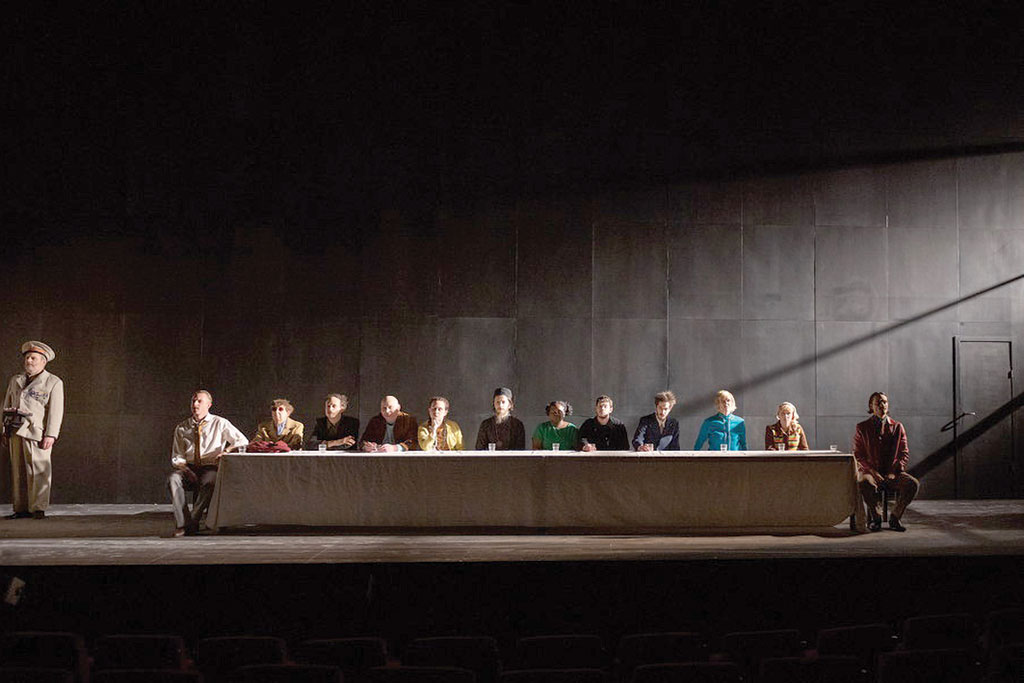
Semyon Podsekalnikov, the insignificant ‘hero’ who is about to sacrifice himself and who in his fleeting glory believes his life will become meaningful through the death he offers to the collective – this seems to be the added value that best explains why this Erdman play remains on stage. Jean Bellorini dwells at length on a Christ simile: in a comic group portrait reminiscent of Leonardo’s painting of The Last Supper, the characters are seen drinking vodka as they wait for Podsekalnikov’s ‘noble’ sacrifice.
Do such actions make any sense? Is there any point in dying for any principle at all?”, the creators of the performance asked, along with the writer, and provided a clear answer at the end of the play. A video clip is shown of a Russian rapper announcing his suicide because of the war, because he does not want to be conscripted or have to point a gun at others. Bellorini told us that the video was included in the performance due to the chilling coincidence that this rapper had the same name as the character who is mentioned in the play but never appears, only the news of his suicide arrives at the end. This is where the farce of around two hours becomes a genuine drama, a reflection on the tragedy of the present. The audience is left wondering which is the more absurd world: the one on stage or life itself? And it may well be that the scales tip towards the latter…
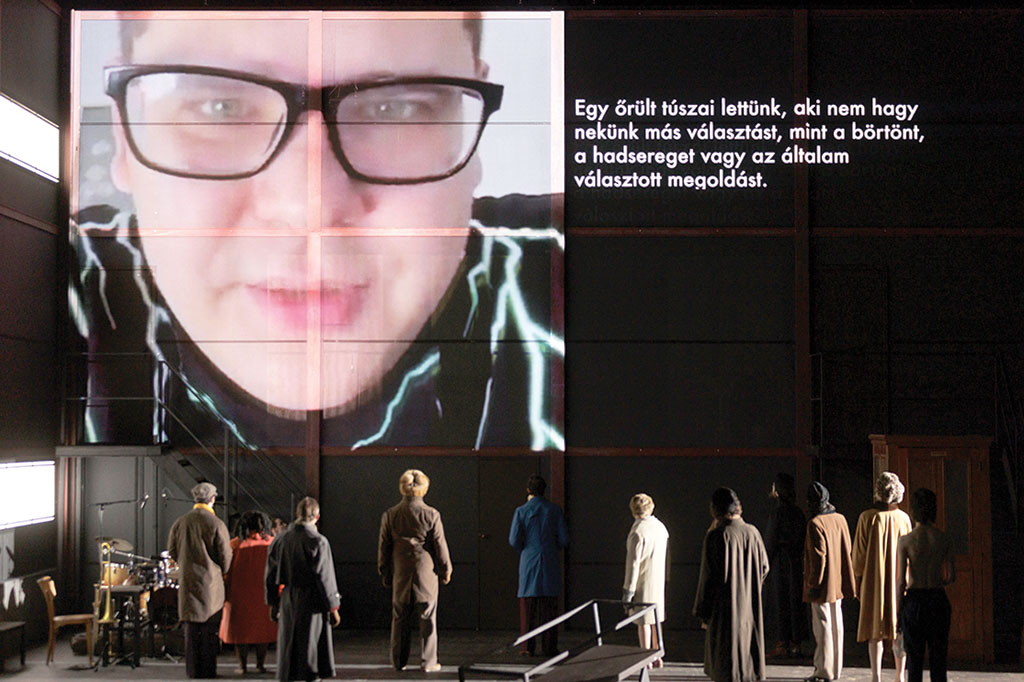
Particularities vs globalisation
In this context, the name and the theatrical world of Tadashi Suzuki should be mentioned again: in addition to the productions by the Suzuki Company of Toga (SCOT)(Electra, The Trojan Women), he also presented his theoretical work at the festival. As part of MITEM’s programme, his book Culture is the Body (translated by József Jámbor) was presented in Hungarian, featuring the master’s writings on the theory and philosophy of theatre. In addition, a special symposium gave us the opportunity to get to know the basics of his theatrical approach and the most important elements of his actor training, with a sample shown in a practical demonstration. The Japanese master, one of the greatest theatre-makers of the 20th century, was driven from the Japanese capital in 1976 by a desire to find his own artistic path and set up his own company in the small isolated village in Toga.
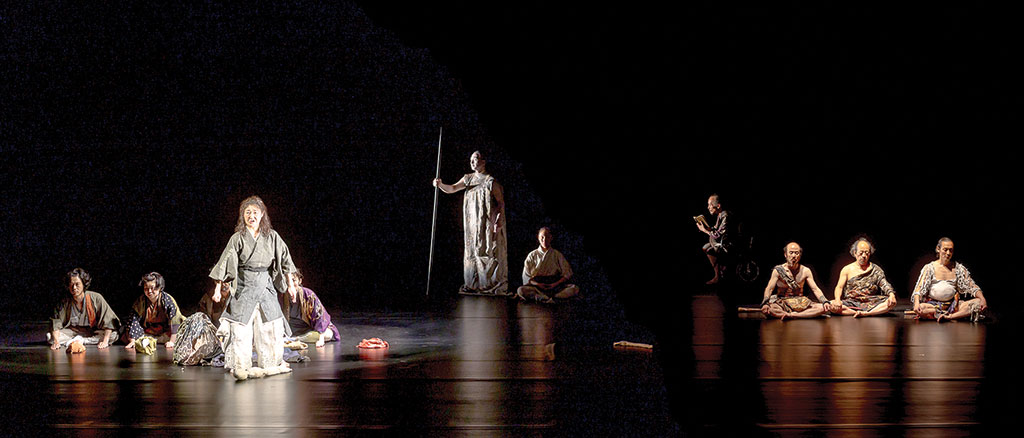
‘To understand the world, you need both a central and a marginal perspective,’ said the creator who sought to establish a centre in Toga from which to extend his vision for the theatre to New York, Paris or even the North Pole. This ambition has proved so successful that the centre, based in a village of around 400, has become one of the world’s best-known theatre workshops, attracting actors from all over the world (including Hungarian actor Gábor Viktor Kozma, a lecturer at Babeş-Bolyai University) to learn this unique method and approach, which has made the Japanese theatre tradition an integral part of contemporary world theatre.
Another senior master, Eugenio Barba, directed the production Anastasis (Resurrection) at MITEM. It is rare to see anywhere in the world so many cultures come together on one stage as in this production based on festive rites and rituals. The ISTA – International School of Theatre Anthropology and Theatrum Mundi Company production was the outcome of a workshop held in Pécsvárad on 8-20 May 2023 under the direction of 86-year-old master Eugenio Barba. Representatives of some thirty nations created this performance, drawing on their own traditions, with Japanese Noh, Chinese Nanquan opera, Balinese Topeng, Indian Baul dance, Kathakali, Brazilian Bumba Meu Boi and flamenco combined in an integral whole. The diversity of the show was dazzling, featuring captivating Japanese, playful Italian, vibrant Brazilian, mysterious Balinese and energetic Hungarian elements.
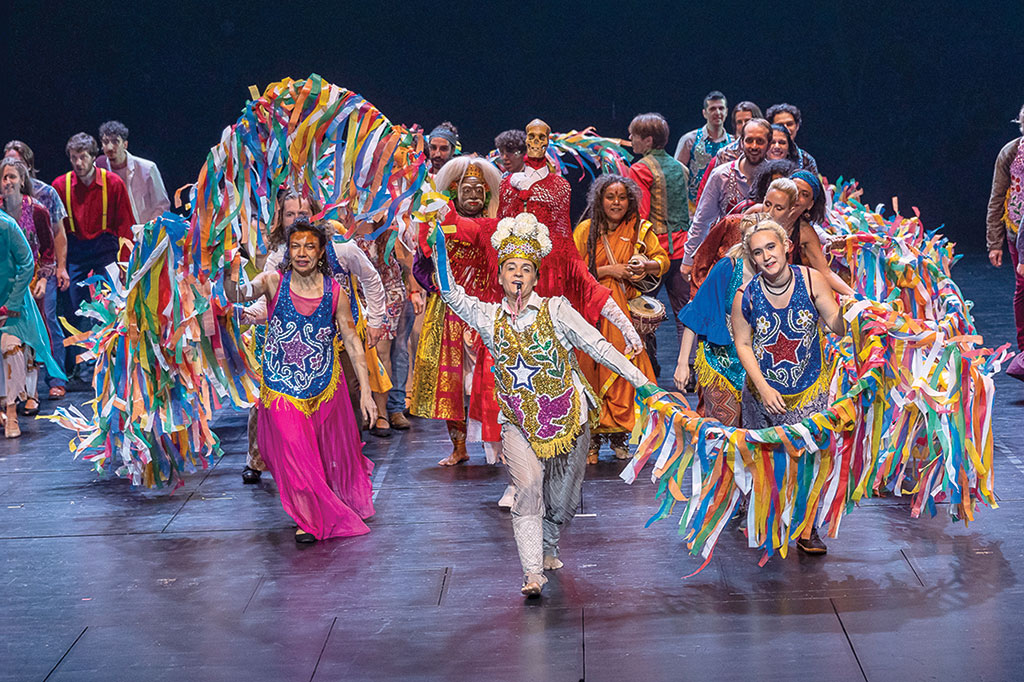
We all probably share the belief that there is a higher, spiritual rebirth, as we saw in this allegorical resurrection story. A perfect harmony in diversity was achieved thanks to Master Barba and his collaborators: we could marvel at the meditative melodies of Japanese Koto, the primordial power of the Baul singer, or the witty and virtuoso duel between Hungarian folk dancer István Berecz and his Brazilian partner, giving the large audience a first-hand experience of today’s exciting world.
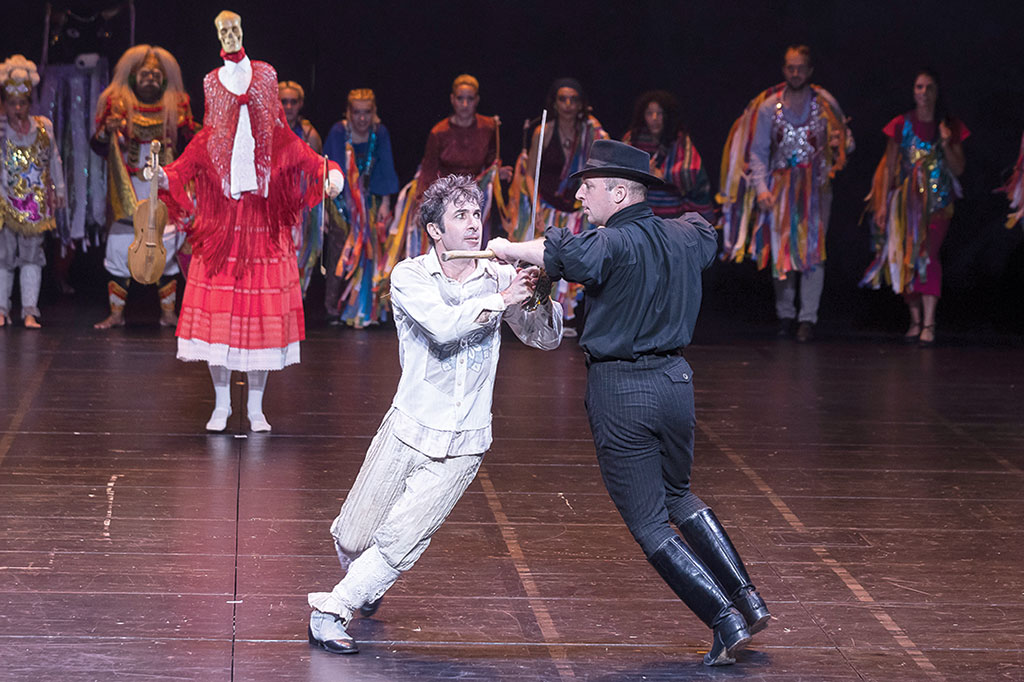
Special cultural links lead via Eugenio Barba’s workshop to the company of Teatro Tascabile di Bergamo, which has collaborated with India’s Kalatharangini Kathakali School to create an amazing East-West encounter in the Indian classical dance theatre production Stories from Mahabharata. The monumental production, lasting around seven and a half hours, astonished the Hungarian audience with its unusual theatrical language.
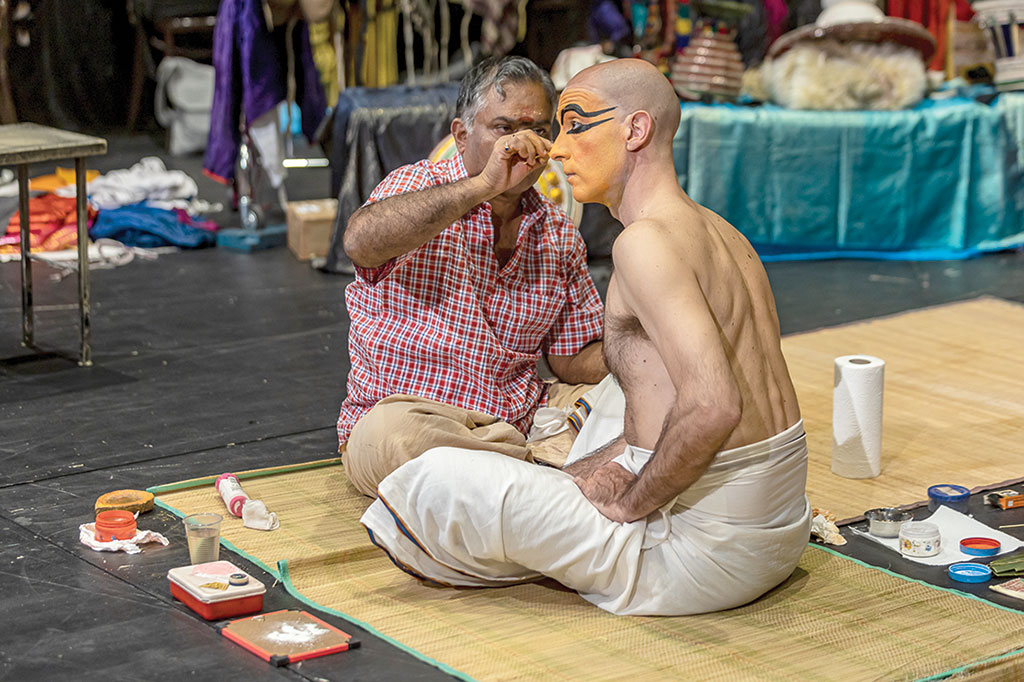
Teatro Tascabile di Bergamo discovered the world of Kathakali theatre some forty-five years ago, as we learned from the introductory remarks of company director Tiziana Barbiero. The team was ‘infected’ by this archaic theatrical form; many have been mastering it ever since. The audience had a chance to prepare for the performance, a Kalatharangini Kathakali School and Bergamo Theatre co-production: those interested could take part in a workshop and learn about Kathakali techniques and get an insight into mask-making. The performance, directed by Dr Kalamandalam John, was based on three stories from the great Sanskrit epic Mahabharata. We had access to a fascinating culture we know so little about. The stories of the child Krishna and an episode from the life of the adult Krishna were presented from sunset to sunrise by Indian and Italian performers. The Budapest audience proved to be very open to this archaic form, as very few people trickled away during the long hours, and those who stayed rewarded the performers, including the musicians, with a standing ovation for their outstanding physical and mental performance: they had worked practically non-stop through the night.
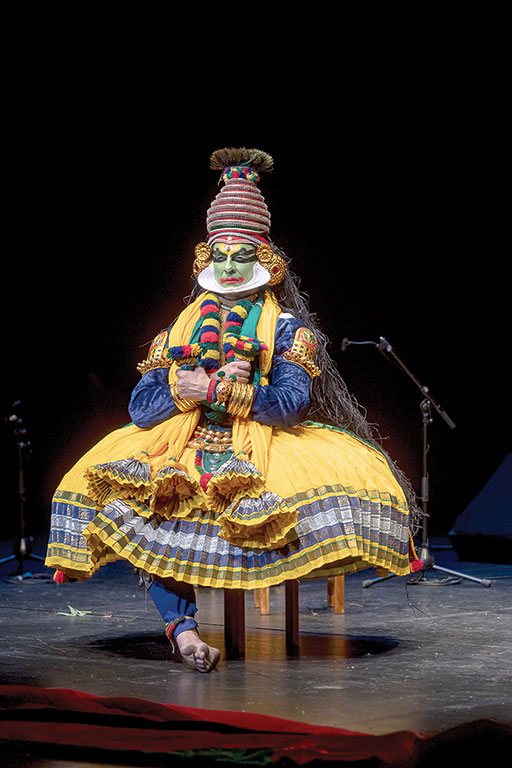
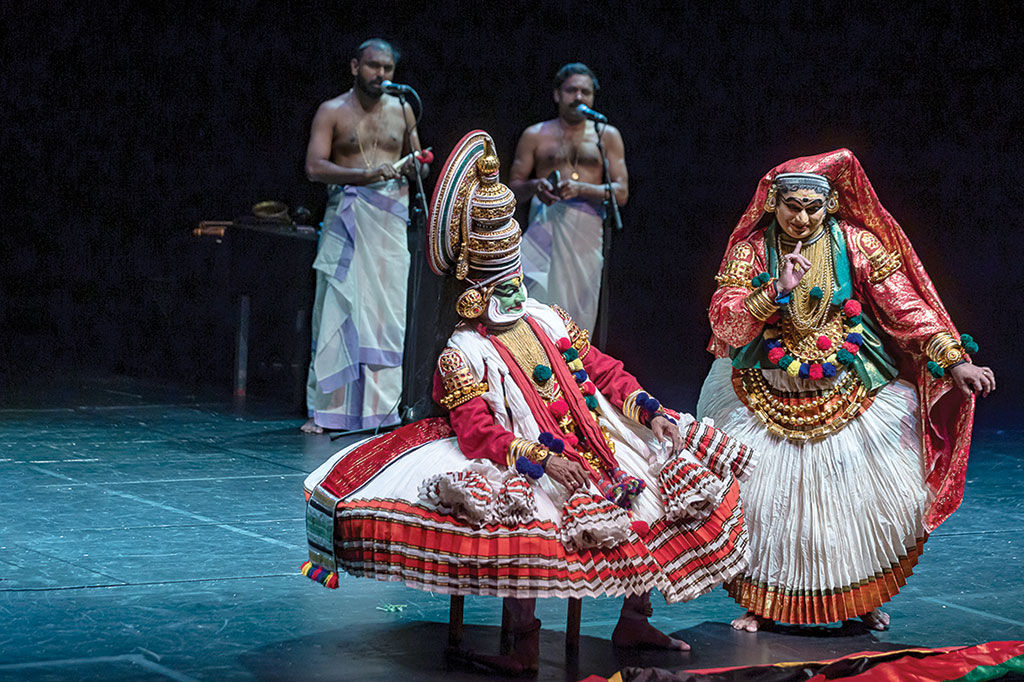
The Tibetan Institute of Performing Arts participated as a guest in the programme with the traditional Tibetan opera The Story of Noble Dakini Nangsa Obum. In an introductory discussion preceding the performance, director Shamten Dhondup told us that after China invaded Tibet in 1951 and the 14th Dalai Lama Tenzin Gyatso fled to Dharamsala, India in 1959, the Tibetan Institute of Performing Arts was established with his support to preserve the values of the Tibetan cultural tradition.

The Tibetan opera itself, which the Hungarian audience could experience for the first time, proved to be quite accessible for us. This is probably to do with the fact that, despite its sacred theme, it is presented as an epic story, rather than as an abstraction like, for example, the Kathakali we saw earlier. The story of the ‘sky-walking fairy’ (as described by the performance) is reminiscent of Christ’s in several respects, particularly in the way he rises to proclaim love in the world. Nangsa Obum’s extraordinary journey on the Inner Path is presented in an abridged version of the opera, with spectacular dance scenes accompanied by beautiful tunes. Although the origins of the Tibetan people are considered uncertain by historians, they themselves, similarly to Hungarians, speak of their Scythian heritage, and they clearly came to their present-day realm of snow from a nomadic horse culture in Inner Asia. Their adoption of Buddhism was similar to our conversion to Christianity. In their case, Buddhism was added as a layer on top of their ancient nomadic-totemic beliefs, which resulted in religious syncretism. Anyone who has seen the Christmas Carol with the Angel from Szentegyháza, Szekler Region, Romania, will know what this is about: a perfect fusion of pagan forms in a Christian story. Buddhist liturgy and the sacred tale of Nangsa Obum, who “was given to earth to liberate a hundred thousand sentient beings with her radiance”, chimes in beautifully with, for example, the circular dance of masked hunters, clearly a pagan heritage, in the shephards’ circular dance at baby Jesus’ manger in the Szentegyháza Carol. And then there are the tingling pentatonic melodies, the singing techniques akin to Hungarian folk singing, and the exciting correspondences with traditional Hungarian costumes. In short, there were many points where we felt familiar with this now exotically distant culture.
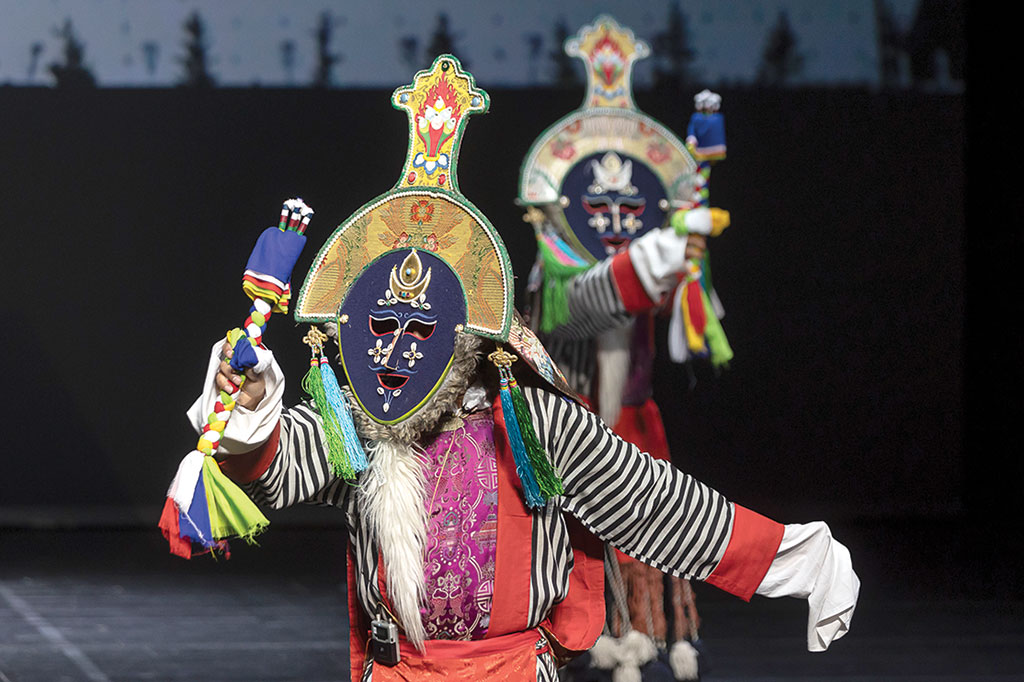
The Algerian Théâtre Sindjab/Sindjab Theatre Company’s production The Sound of the Sand presents the desert peoples’ rituals related to rain and water, which are so important to them. The company has already taken part in MITEM in recent years, and Omar Fetmouche’s production Bravo to the Artist, partly based on the director’s own experiences, has also come to Budapest. This time, he went deeper: he incorporated rituals from his region and his homeland. We learnt that the dialogue on theatre that started in Budapest in 2021 inspired him to formulate a theatrical message for his region. Omar Fetmouche also told the audience meeting about the 30,000-year-old stone engravings of dance moves found in the Sahara region in the heart of Algeria. These rock drawings also prove that the region has a very ancient culture with many ancient rites.
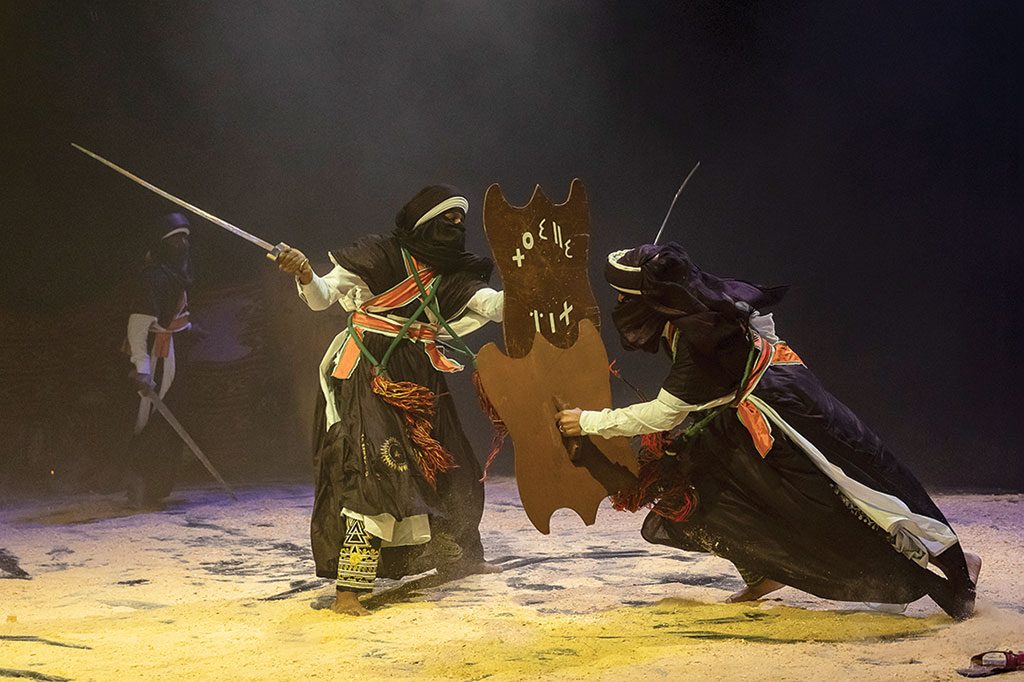
The first part of the production presented the mythical story of Anzar, the god of rain and water in Berber mythology, who is rejected by a maiden he chose and who, therefore, punishes people with drought. Water is the source of all life forms and is a particularly important element for the Saharan peoples, which is why these rites are also of particular importance, the director underlined. The second part depicted a Tuareg tribal battle and the rite of Sebiba (Sebeïba). The latter is a kind of artistic duel, an abstract version of tribal fighting that, according to Fetmouche, has been going on unchanged for a hundred years in the south of Algeria. Descriptions suggest that its origins go back to ancient times. It is believed that when Moses defeated Pharaoh, the two tribes of the Tassili n’Ajjer made peace, hence the annual event in the province of Djanet in South-East Algeria. The ceremony, which takes place in a circular space, involves singing, dancing and dressing up in a contest of strength, where participants lay down their weapons, as during the ancient Greek Olympics, and compete in the field of arts. This rite has been on UNESCO’s World Heritage List since 2014.
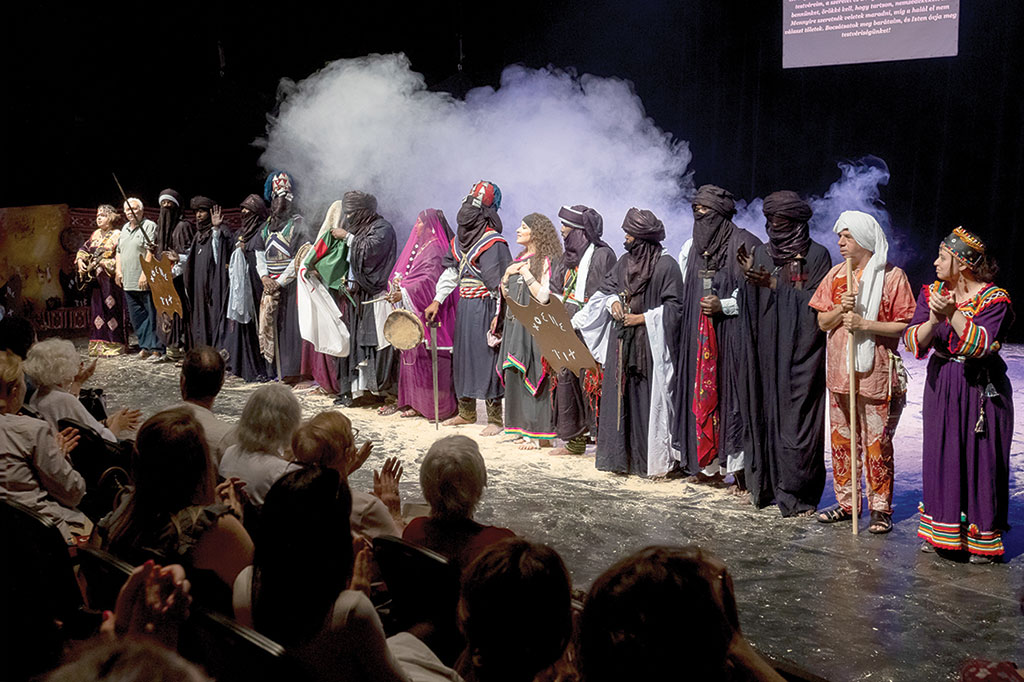
One of the curiosities of the meeting in the field of East-West dialogue was the contemporary Chinese adaptation of Faust, produced by Beijing’s Central Academy of Drama. The Chinese creators (author Yang Zhankun and director Liu Libin), who significantly rewrote Goethe’s work, chose an interesting dramaturgical solution: we follow the episodes of Faust’s story in reversed sequence… Western-style rampant individualism, of which Faust is one of the first literary representations, is in sharp contrast with the predominantly collectivist approach of Asian societies and their humility in the face of community values. As the director pointed out, there are, however, links: ‘In China, we tend to draw parallels between the title character in Faust (1832) and the Monkey King in Journey to the West (1592): both are folk-tale heroes, both have inspired many works and adaptations, both have been staged in many forms. The two stories illustrate the differences and complementarities between Chinese and Western cultures”.
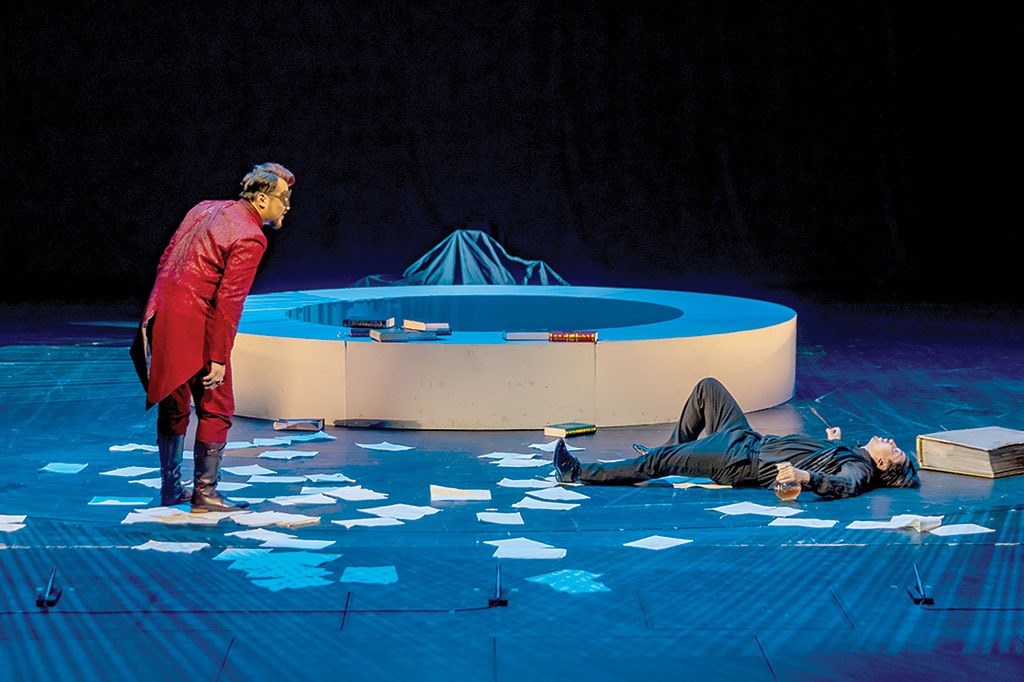
The Hungarian audience could, above all, marvel at the stylized elements of the performance. There was no real need for costume changes between scenes, one or two characteristic moves indicated the transitions, and this was especially well done by Xie Yuchuan playing Mephisto. The lead singer Yikesang Tayier (Faust), showed convincing dramatic prowess despite his young age, while Sun Jingfei (Gretchen) had a very fresh and natural stage presence. The musical eclecticism of the performance did not coalesce in a complete whole, a kind of old-school operatic style dominated the stage at times: the characters sang arias frontally, facing the audience directly. But the spectacle was beautiful and impressive, the circular rotating stage element suggesting that we humans essentially travel down the same Faustian path. The spiral curtain above the circular element was also a key part of this simple but effective stage set (set designer: Sun Daqing), symbolising a higher level of the cycle: man’s journey ever upwards, rising toward the sky.
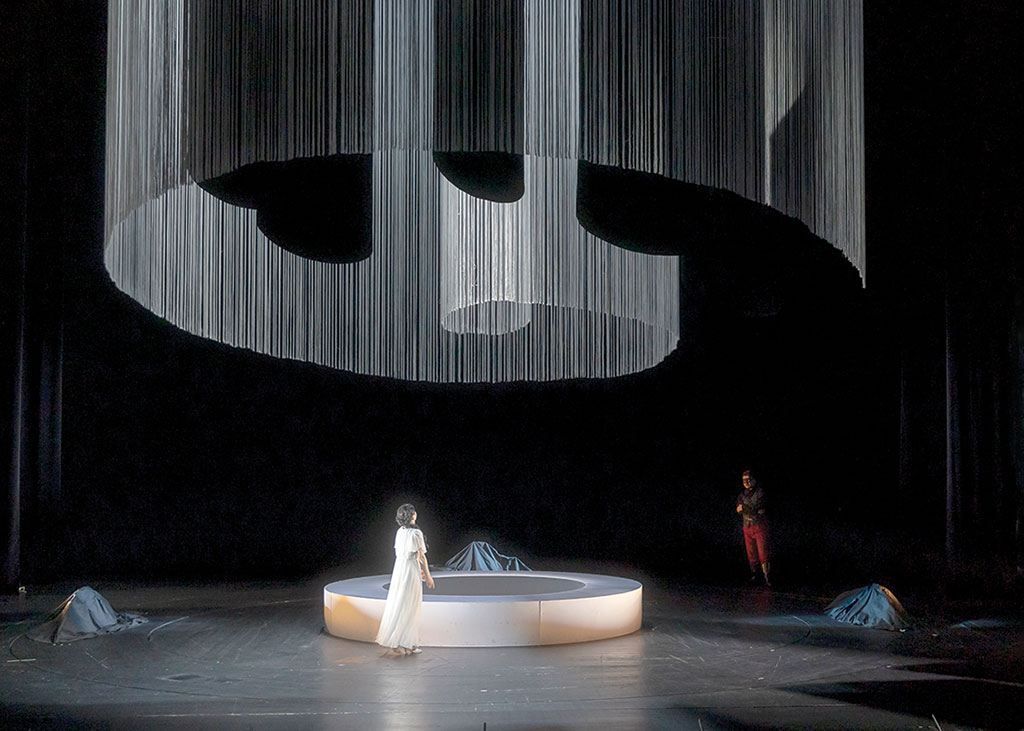
There was also some real theatre magic in the East-West dialogue. On the Miklós Bánffy Stage of Eiffel Art Studio, we saw Silviu Purcărete’s extraordinary Kabuki adaptation The Scarlet Princess of Edo, an irrevocable marriage of Japanese and Western European theatre.
This Japanese Kabuki classic written in 1817 by Tsuruya Nanboku IV. was luckily discovered by Romanian grand master Silviu Purcărete, who saw (not without reason) a kind of Shakespearean parallel, based on which he created his own theatrical vision. The story of Princess Sakura was a sensation in the Kabuki world of the Edo period with its decadently radiant beauty. This epic about soap opera-loads of love-passion-treachery-hatred-revenge was a sound basis for Master Purcărete on which to create a piquant, original masterpiece in his wizard lab. The Scarlet Princess of Edo had its world première at the 2018 Sibiu International Theatre Festival, and has since toured Brussels and Japan, where critics praised it as ‘a European theatre genius’s poetic homage to a Japanese classic’ (Tokyo Festival 2022). Magic is truly the best word to describe the brilliant playfulness with which Purcărete handled this material. Starting with the idea that women are played by men, and men by women. In the Japanese tradition – as in Shakespeare’s theatre, of course – female roles were played by men; the Romanian director added one more twist. To mention just the two main characters: Ofelia Popii and Iustinian Turcu accomplish amazing feats (Ofelia Popii playing two diametrically opposed male characters).
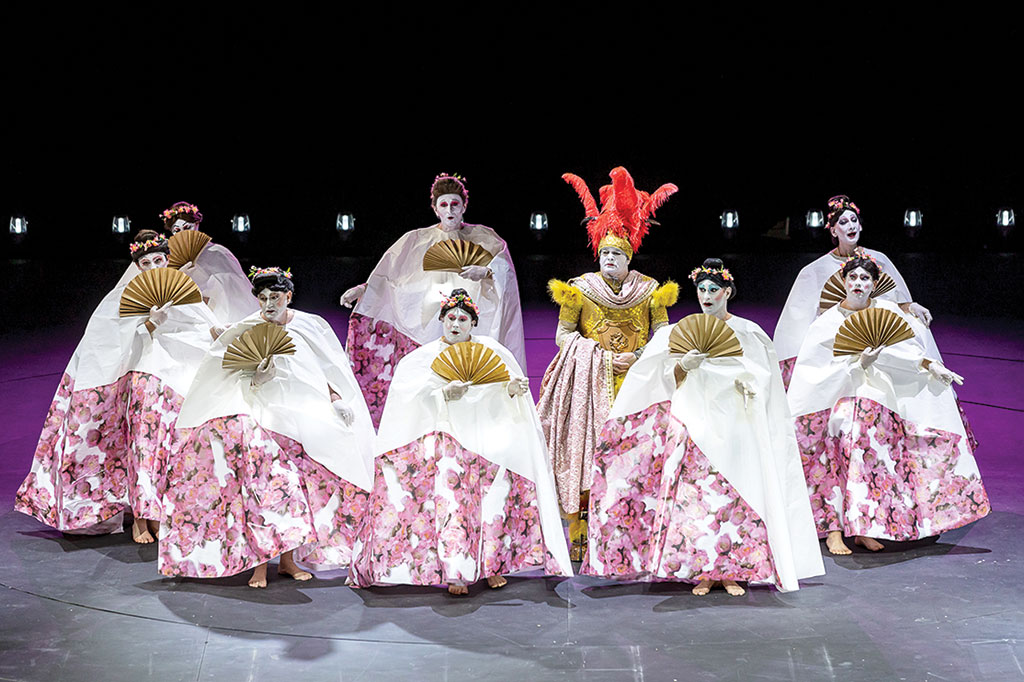
Radu Stanca National Theatre of Sibiu, 2018, d: Silviu Purcărete
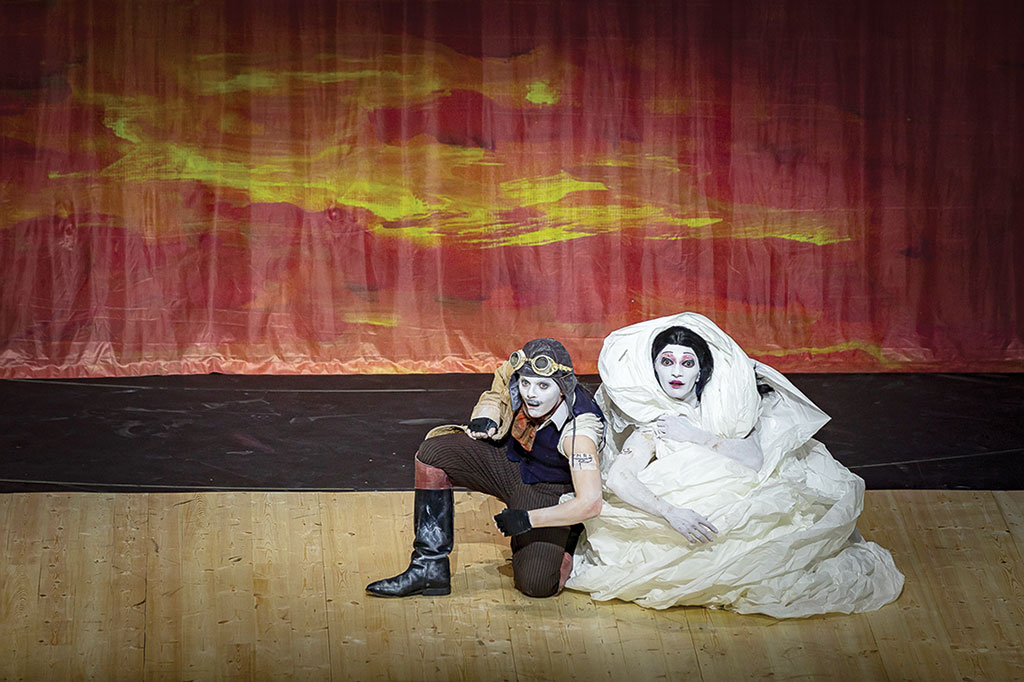
Japanese critics had reason to describe the production as Silviu Purcărete’s most playful, intelligent, humorous and rich performance, ‘a perfect harmony of East European sensibility and the Japanese spirit’.
According to the Romanian author, Kabuki has a lot in common with Shakespeare’s plays, mainly because both are a particular mixture of tragedy and comedy. The Budapest audience could see this for themselves: it was really like watching a Shakespeare comedy and a traditional Japanese theatre performance at the same time. The Purcărete productions at MITEM (Faust, Gulliver, The Tragedy of Man) demonstrated the Romanian master’s ability to forge a distinct signature style in his oeuvre. This unique East-West adaptation of The Scarlet Princess of Edo established a new genre: ‘fusion theatre’. Silviu Purcărete is – no doubt – a genuine theatre wizard…
From the world of contemporary Mexican theatre, we were treated to three memorable and very different productions by Teatro de Babel and the Mexican National Theatre, the most exciting of which, in terms of theatrical form, was perhaps Emiliano Zapata’s Women, written and directed by actress and playwright Conchi León, about the 19th century Mexican revolutionary Emiliano Zapata. In a post-show discussion, Conchi León revealed that Zapata’s story was really just an excuse for her to talk about women’s issues, living in a society where 10-15 women are still killed every day and many disappear without a trace. In staging this current phenomenon rooted in the past, the authors seek a theatre language to dialogue with today’s audiences, boldly mixing 19th-century romantic-heroic stories with archaic ritual theatre and modern political theatre on women’s issues, using elemental playfulness and humour. There were excellent actors, including the director herself, along with Judith Inda and Karla Camarillo.
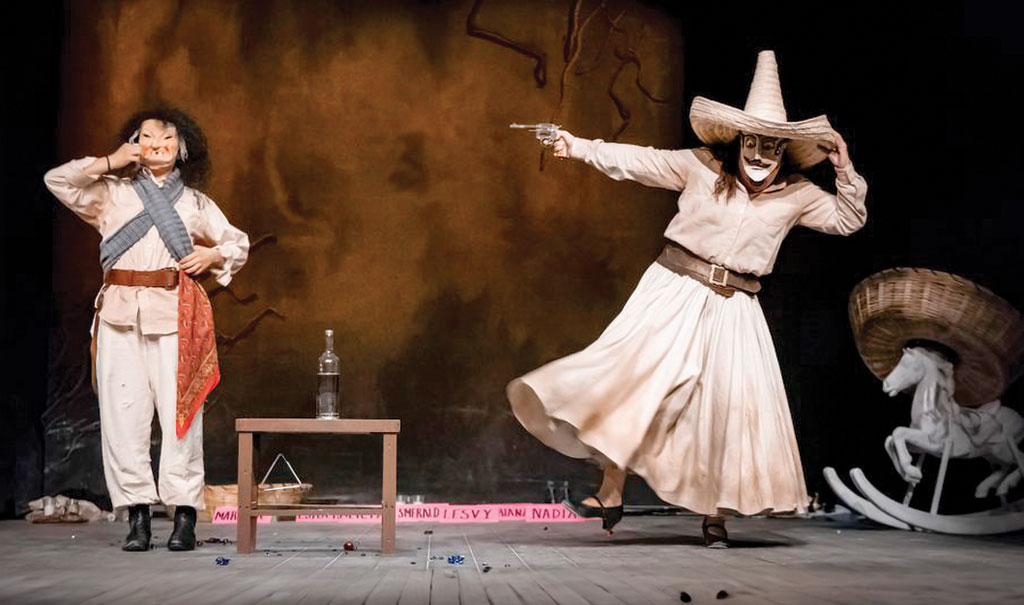
The other contemporary Mexican play also focused on women’s issues. Written and directed by Aurora Cano based on Chekhov’s Three Sisters, Moscow explored the subject of disengagement. Blending a contemporary sense of life with avant-garde forms and powerful poetic texts, the play focuses on three actresses who address issues around women’s autonomy, emancipation and sexuality.. The dramatic conclusion is reached via a series of local and universal scenes: while the three sisters longing for Moscow end up lonely, here the young girl who wants to go to Montreal is shot just as brutally as the intellectual woman struggling with motherhood. The discussion following The Fundamentalist, based on Juha Joleka’s play on the relationship between a successful priest having renewed his faith and his ex-mentee, a girl who subsequently joined a cult, was arguably more exciting than the performance itself.
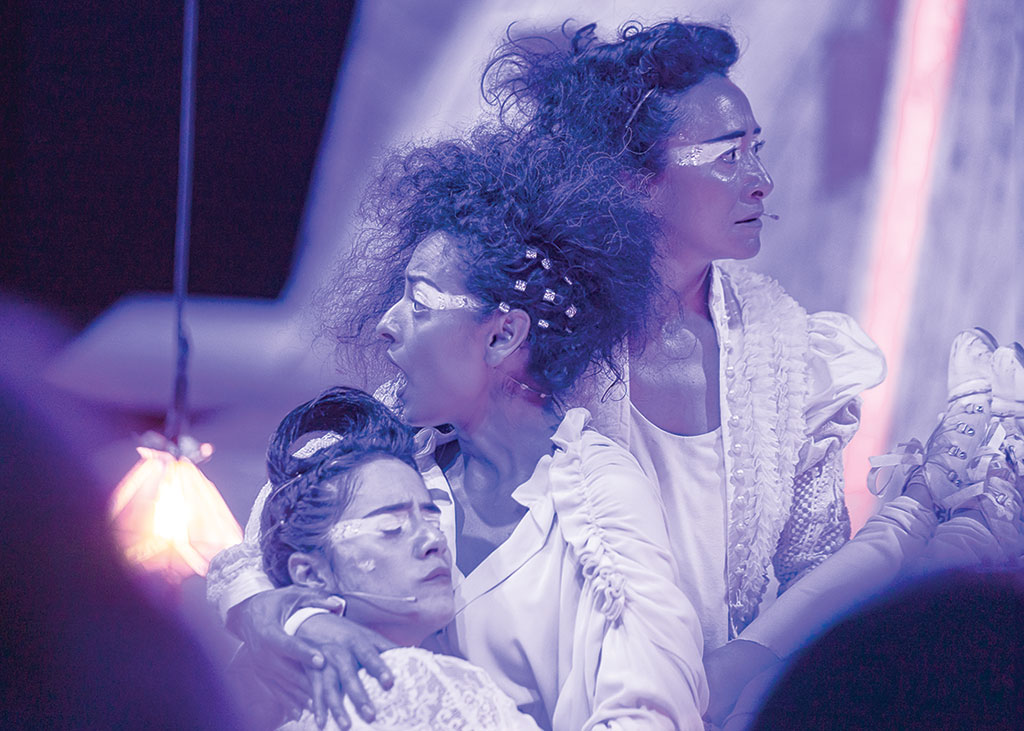
‘Mexico is a country of denial, torn apart by different identities, while their synthesis is also present,’ – said one of their actors, Luís de Tavira. Aurora Cano explained that Mexico is characterised by a strong cultural syncretism, since, unlike the nomadic cultures European immigrants found in North America, Mexico had great empires at the time the European conquerors arrived. As Aurora Cano put it, ‘When chocolate (a Nahuatl word) met cow’s milk (cows are not native to the Americas), the world changed. That is also a metaphor for the meeting of cultures. Mexican culture is the result of the very intense encounter of Spanish culture, based on European values, with the ancient, often brutal, bloody, ritualistic local culture.
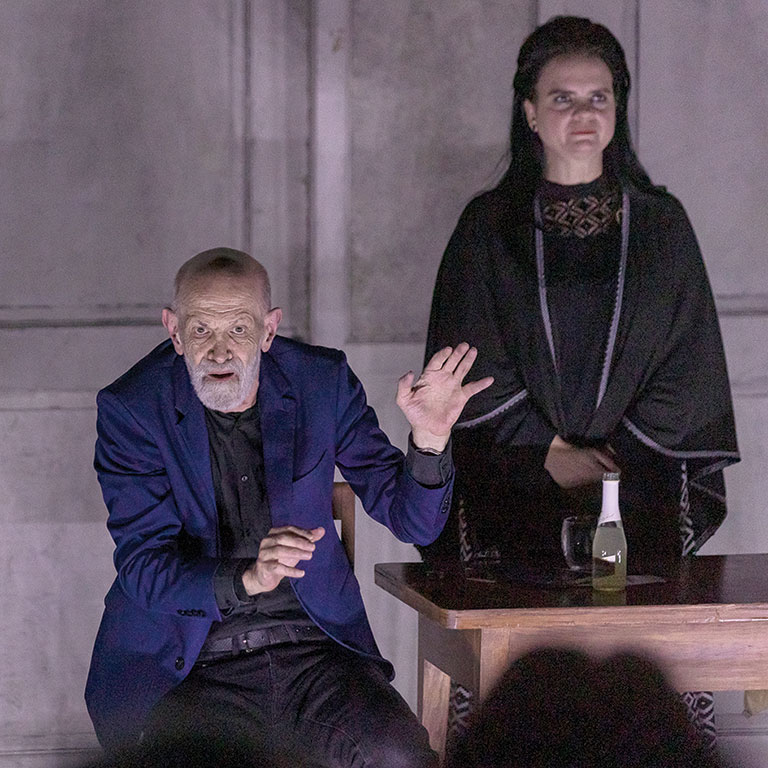
Some foreign productions have not been mentioned yet, because they were, in a way, separate islands in the huge programme.
***
A case in point was the festival’s opening performance, Theodoros Terzopoulos’ Nora, based on Ibsen’s A Doll’s House. The Greek grand master of theatre told the audience meeting that he was looking for transformation and transcendence in the figure of Nora, a part of consumer society and prisoner in a relationship where she and her husband play a masochistic game. The transformation she undergoes is not only a story of liberation, but also a story of theatre and life itself, as constant change is at the heart of both. ‘A still life is death,’ – said the Greek master who believes that theatre, and art in general, can save the day precisely by granting us this transformation.
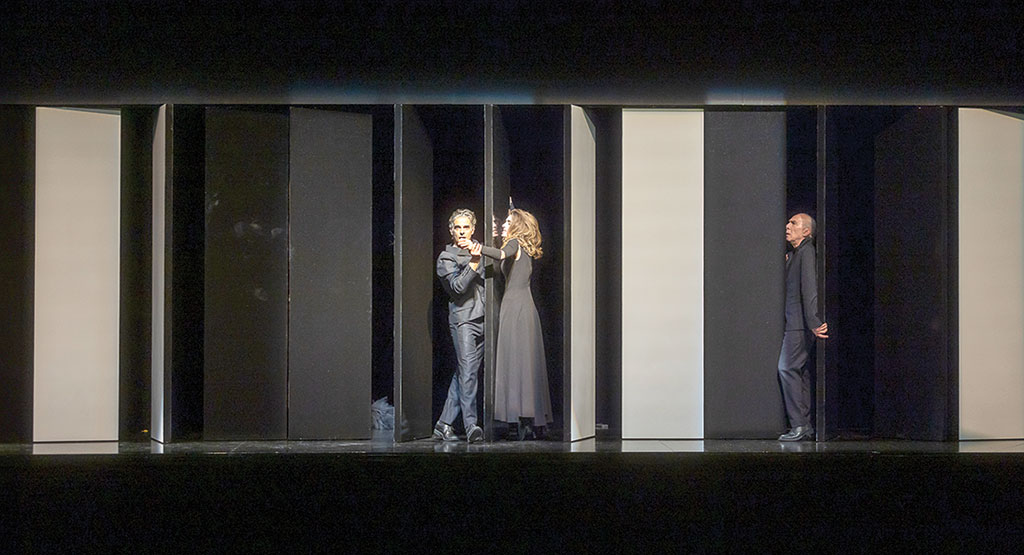
Young Barbarians, a production by the State Hungarian Theatre of Cluj, directed by Attila Vidnyánszky Jr. and written by Miklós Vecsei H., is an interdisciplinary cavalcade inspired by the lives of Bartók and Kodály. The production presented the trials and tribulations of the two emblematic Hungarian composers, especially Bartók, using an astonishing array of associations and ideas. In the course of just over three hours, the authors bombarded an unsuspecting audience with a barrage of impulse bombs, creating a uniquely poetic collective performance about a genius who happened to be very frail and fallible as a human being, but very full-bodied in his music, capable of unleashing ‘barbaric’ energy. Bartók, whose character is designed to amuse, is played (brilliantly) by a fragile woman, Éva Imre. This improvisation-based permanent intellectual vibrancy somehow still managed to evoke very profound experiences in the audience, opined the authors, and ascertained the spectators in the auditorium.
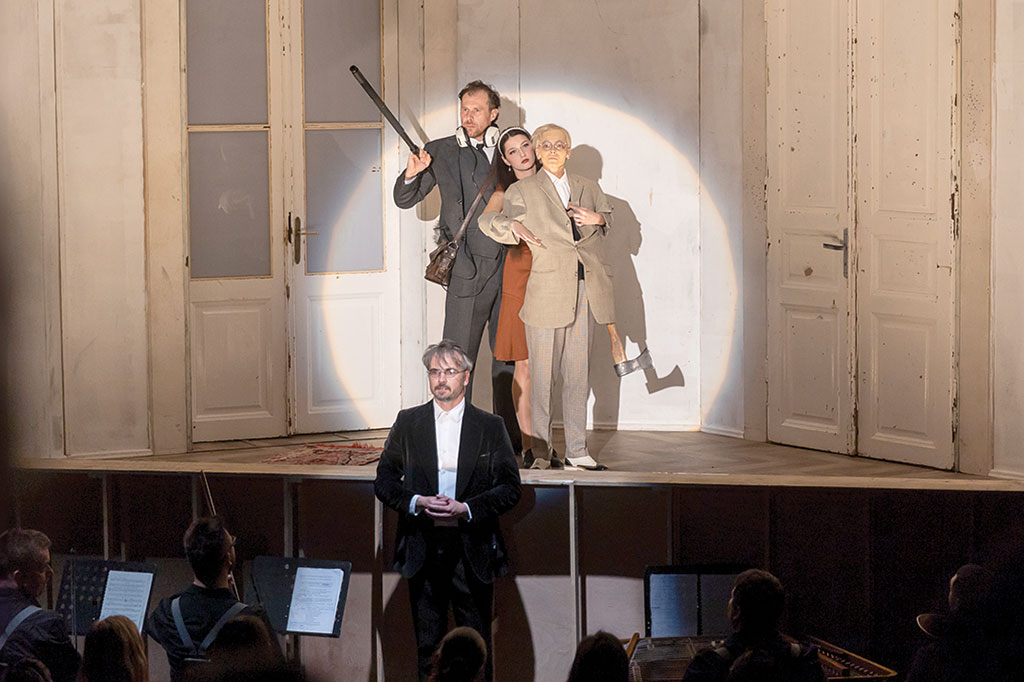
Young Barbarians, State Hungarian Theatre of Cluj, 2022, d: Attila Vidnyánszky Jr.
Emma Dante brought yet another astonishingly human story to Budapest. After her latest hit Misericordia, the Italian director returned to MITEM with Blackcaps’ Tango, an Atto Unico co-production with several partners. In this production, the author presented an accurate psychological roadmap of a couple’s relationship, using a fascinating flashback technique to tell the story backwards in time, starting with the end. A lonely end, as one of the characters (in this case, she) is left alone after her partner’s death and recalls their shared experiences, in reverse order. First come the challenges of old age, then the middle-aged couple are ‘bored’ in front of the TV, then their child is born, then the wedding, how they became a couple, and finally, how they first met. Demonstrating how two people can live together a whole life long, if they choose well and stay by each other’s side. Because such cases do exist. Manuela Lo Sicco and Sabino Civilleri beautifully captured the euphoria of the simplest, most ordinary moments of life and the awkwardness hidden is some of its highlight moments – such is our life.
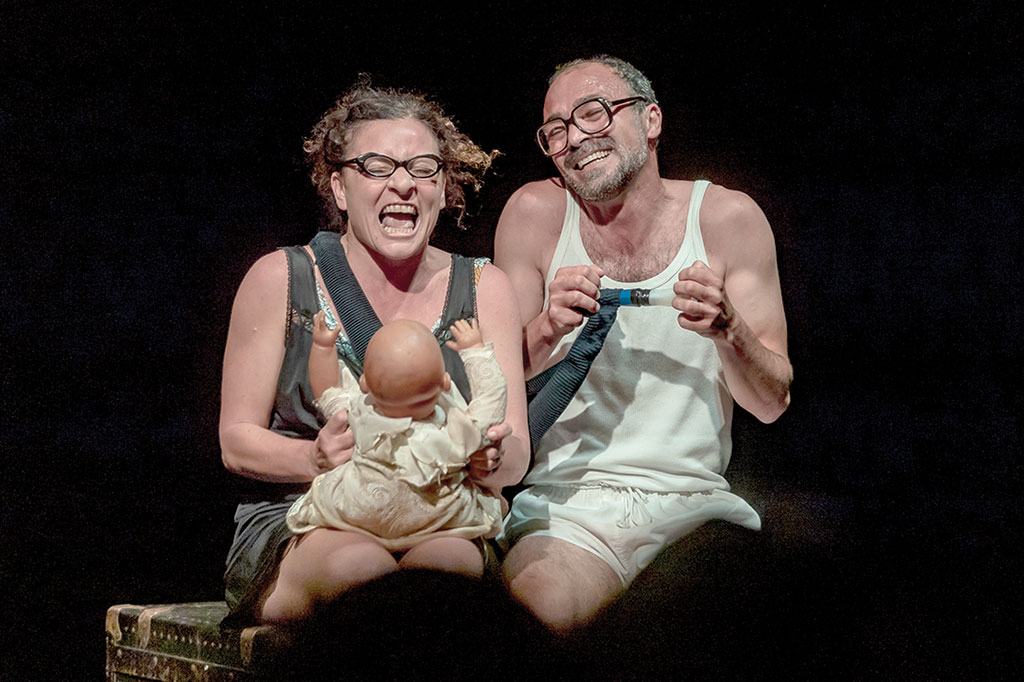
Finally, special mention should be made of a spiritual foreign production brought to MITEM by France’s international superstar Juliette Binoche. Excerpts from Gitta Mallász’s book Talking with Angels were staged as a reading performance entitled The Matter of Light. With the help of the French actress and Nelli Szűcs, Zsuzsa Varga and Zsolt Trill, the mystical events of 80 years ago came to life, teaching four young people about faith, love, and their mission in life. The author alone survived the inferno of the Second World War and took her notes to France, where the book was finally published thanks to Gyöngyi Kardos. Originally written in Hungarian, it has since been translated into 25 languages and is now part of Hungarian literature.
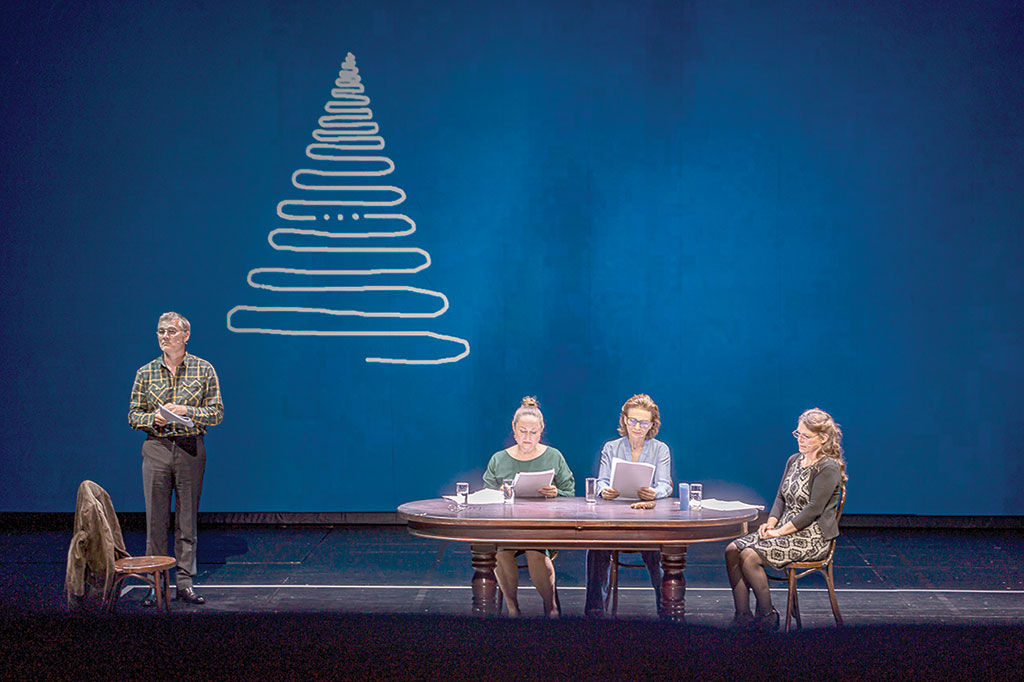
All photos were taken by Zsolt Eöri Szabó, source: nemzetiszinhaz.hu
Translated by László Vértes
[*] The Theatre Olympics mindset and collaboration: Theodoros Terzopoulos and Suzuki Tadashi in conversation – 18.04.2023.
(27 September 2023)











